
Many symbols of the Confederacy — including statues, names, and flags — have been removed from public places nationwide. Still, many state flags to this day contain such divisive symbols, often considered racist. Most recently, Mississippi voted to replace its 126-year-old state flag, which featured the Confederate battle symbol. Instead, the new flag will include a white magnolia blossom.
24/7 Tempo reviewed the meaning of each state’s official flag using information from several encyclopedias, state government websites, and online state libraries. We included the date on which the current flag was officially adopted. Dates of subsequent modifications of the design or previous version of the flag were excluded.
The American flag is ubiquitous. People recognize it and know what every star and stripe represent. State flags don’t really enjoy the same fame.
A state’s flag is its emblem. Therefore, most flag designs include geographical features, historical dates, or symbols of industries that best represent the state.
Though state flags have their own combination of colors, shapes, and symbols, all U.S. state flags are rectangular with one exception, the pennant-shaped state flag of Ohio.
A big influence from the earliest time in American history is Native American culture, apparent in several flags — as well as state names. This is how each state got its name.
Click here to see every state’s flag and what it represents
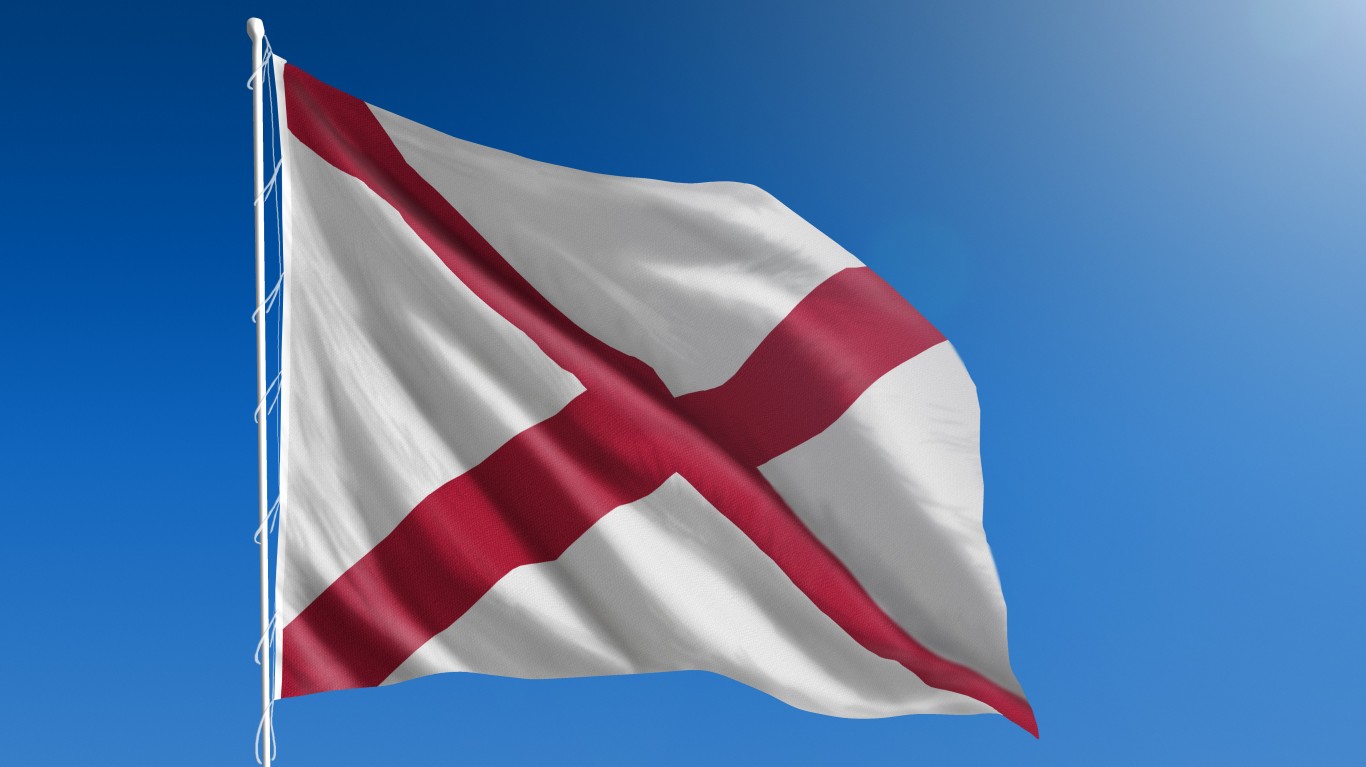
Alabama
> Flag design: A crimson cross of St. Andrew on a field of white
> Officially adopted on: 1895
Alabama’s flag design is very similar to the Spanish Cross of Burgundy, used in southern Alabama until the 1800s. The original square shape symbolized the battle flag of the Confederate States of America, which featured a blue diagonal cross, trimmed with white — with 13 white stars for the 11 states of the Confederacy plus Missouri and Kentucky — on a red field.
[in-text-ad]

Alaska
> Flag design: 8 gold stars, forming the Big Dipper and Polaris, on a dark blue field
> Officially adopted on: 1921
Alaska’s state flag, designed by a 13-year-old orphan, Benny Benson, features the Big Dipper, also known as the Great Bear constellation. The Big Dipper is a symbol of strength. The Polaris, or North Star, on the flag is a symbol of Alaska’s northern location. The blue background represents the sky.
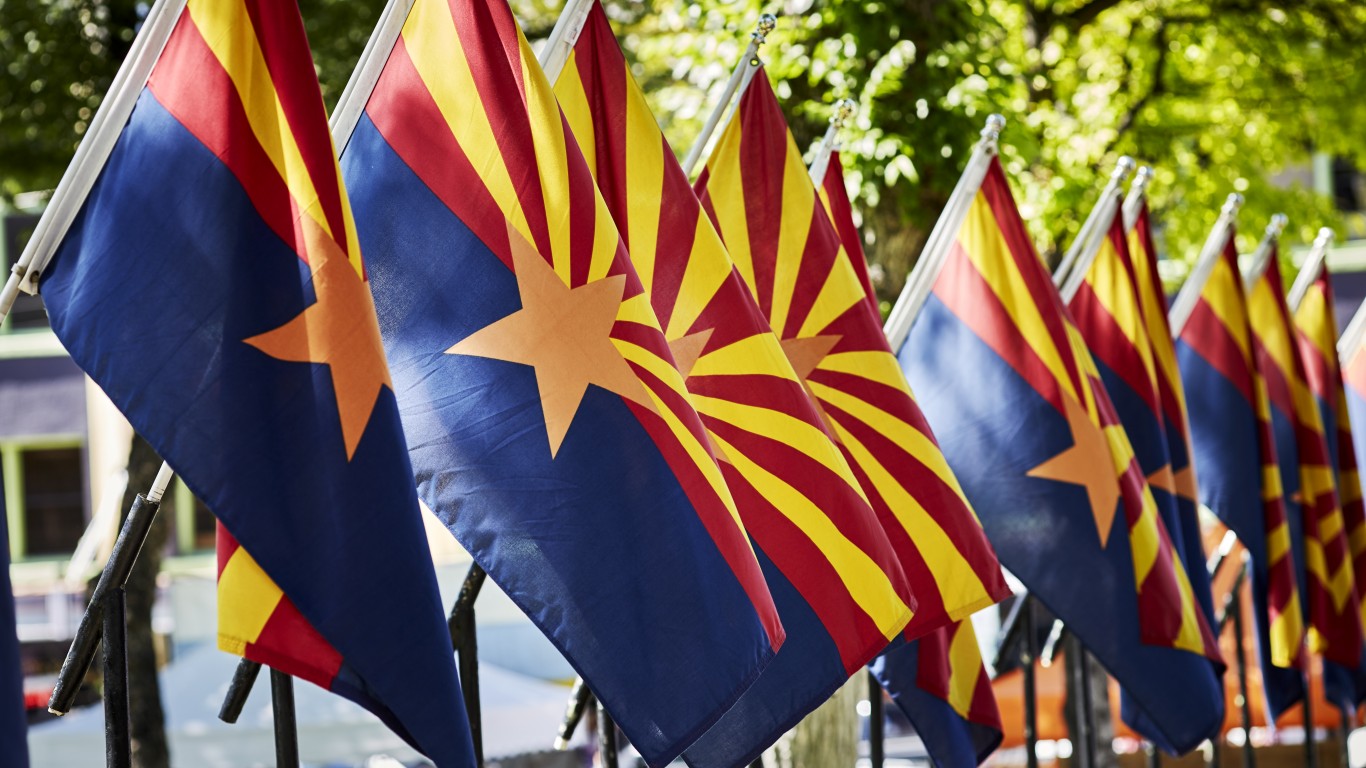
Arizona
> Flag design: 13 rays of red and weld-yellow on the top half
> Officially adopted on: 1917
The copper star on Arizona’s flag signifies the state’s copper production. Arizona produces more copper than any other state in the country. The 13 gold and red rays on the flag are a symbol of the sun setting over the western desert and the original 13 colonies.
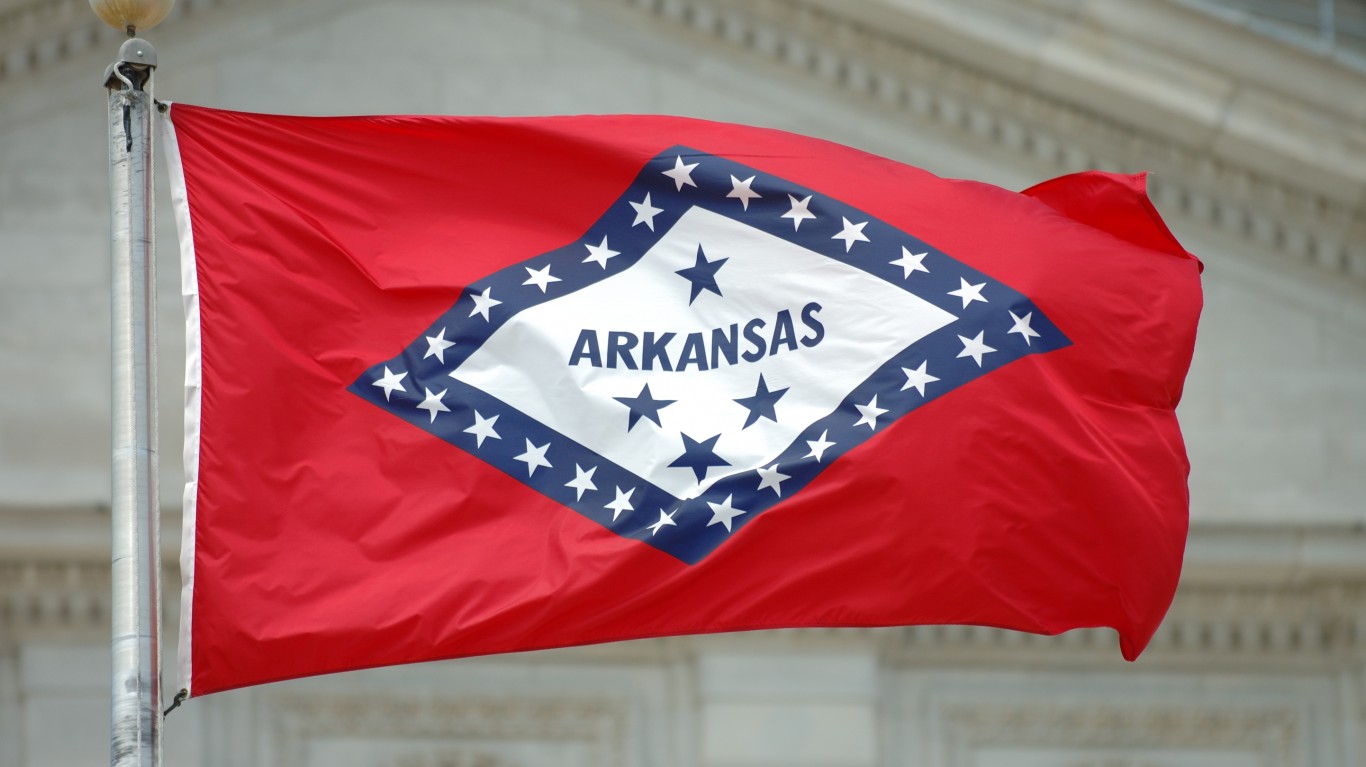
Arkansas
> Flag design: A red field with a large blue-bordered white diamond, and 29 stars
> Officially adopted on: 1913
The large diamond in the middle of Arkansas’ flag represents the state as the first in the country to produce diamonds. The 25 white stars signify that Arkansas was the 25th state to join the Union. The three blue stars below the state’s name on the flag represent the three nations that Arkansas was part of before it officially became a state — Spain, France, and the U.S. The lone star above the word “ARKANSAS” represents the state’s membership in the Confederacy.
[in-text-ad-2]
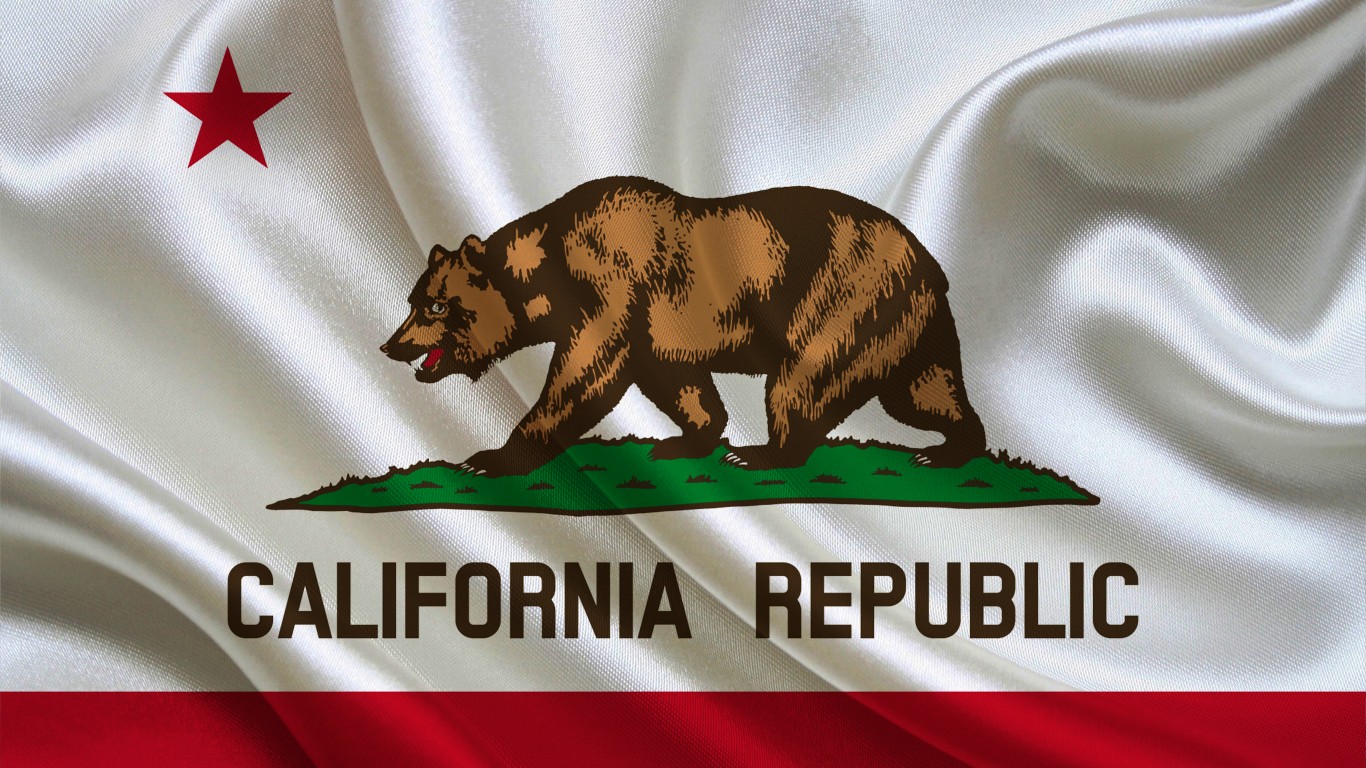
California
> Flag design: A red star, a red stripe along the bottom, and a California grizzly bear
> Officially adopted on: 1911
California’s flag showcases the state’s official animal, the grizzly bear, which portrays strength. The star represents sovereignty as do the words “California Republic.” The flag was first raised at Sonoma, California, in 1846 by American settlers in revolt, proclaiming California to be an independent republic.
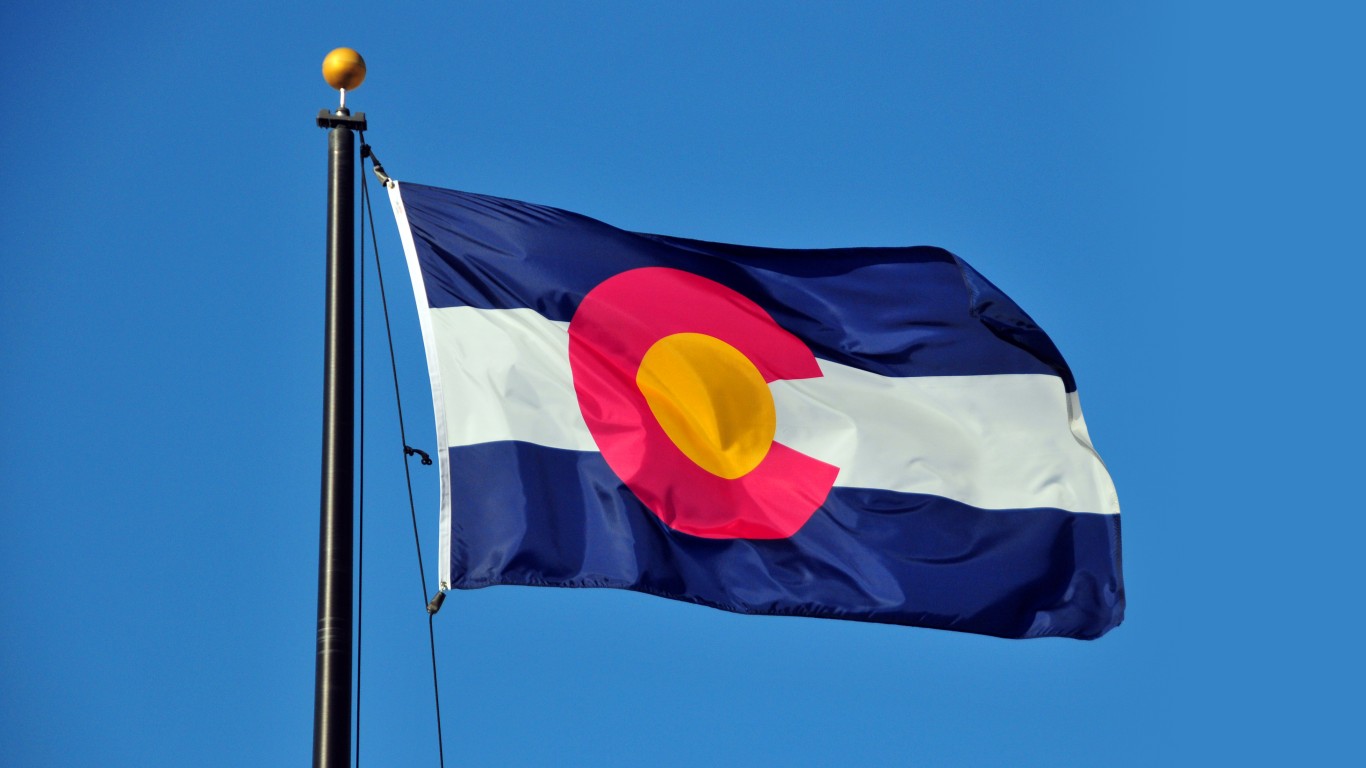
Colorado
> Flag design: 3 horizontal stripes of blue and white, with “C” in the center filled with a golden disk
> Officially adopted on: 1964
The “C” at the center of Colorado’s flag stands for the state’s name but also signifies columbine, the state flower, and centennial, as the state was admitted to the Union on the 100th anniversary of the American revolution. The colors represent the environmental features of the state. White symbolizes the snowy mountain peaks, and gold acknowledges the abundant Colorado sunshine as well as gold production in the state. Blue is a symbol of the state’s skies.
[in-text-ad]
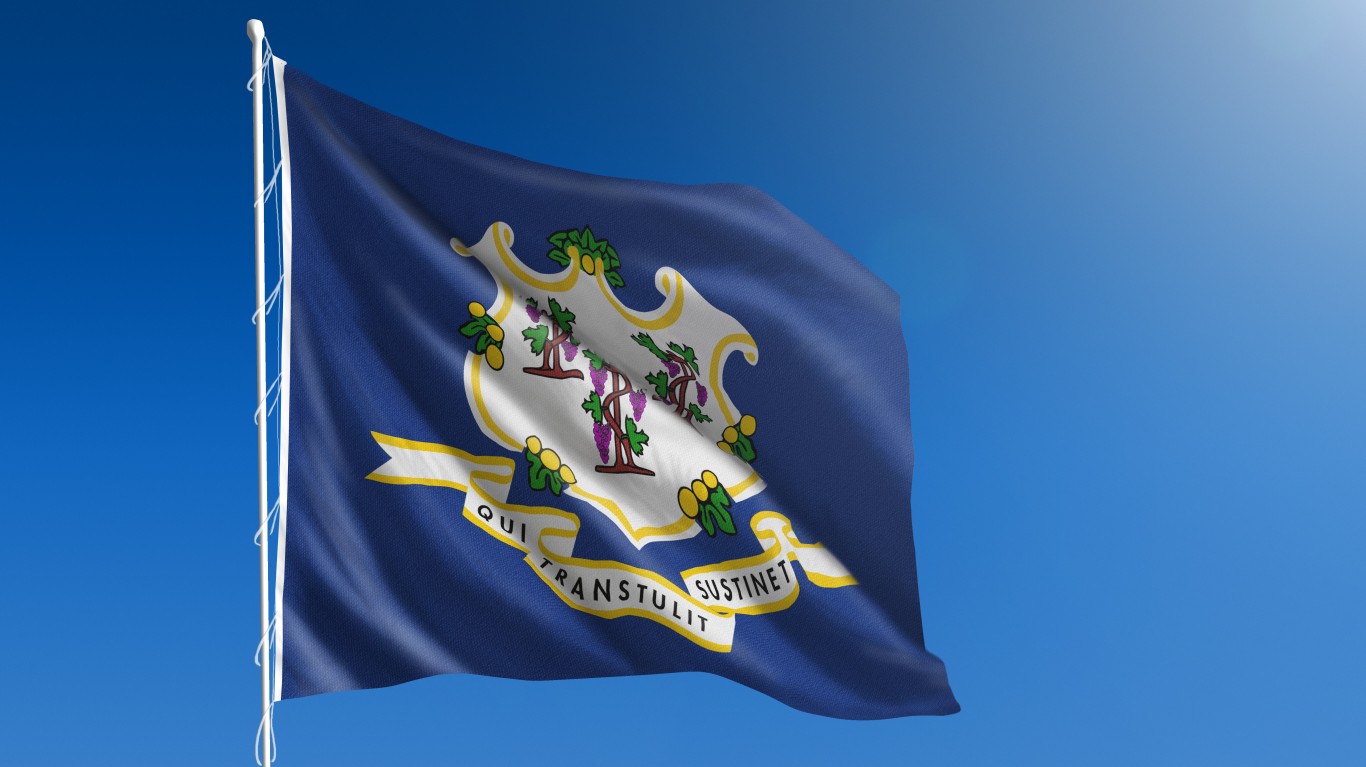
Connecticut
> Flag design: White shield with three grapevines on a field of azure blue
> Officially adopted on: 1897
The three grapevines on the state’s coat of arms are believed to symbolize either three colonies in the Connecticut region or the first three towns established in the region by Europeans — Hartford, Wethersfield, and Windsor. The flag includes a ribbon with the state motto, “Qui transtulit sustinet,” meaning “he who is transplanted still sustains.”
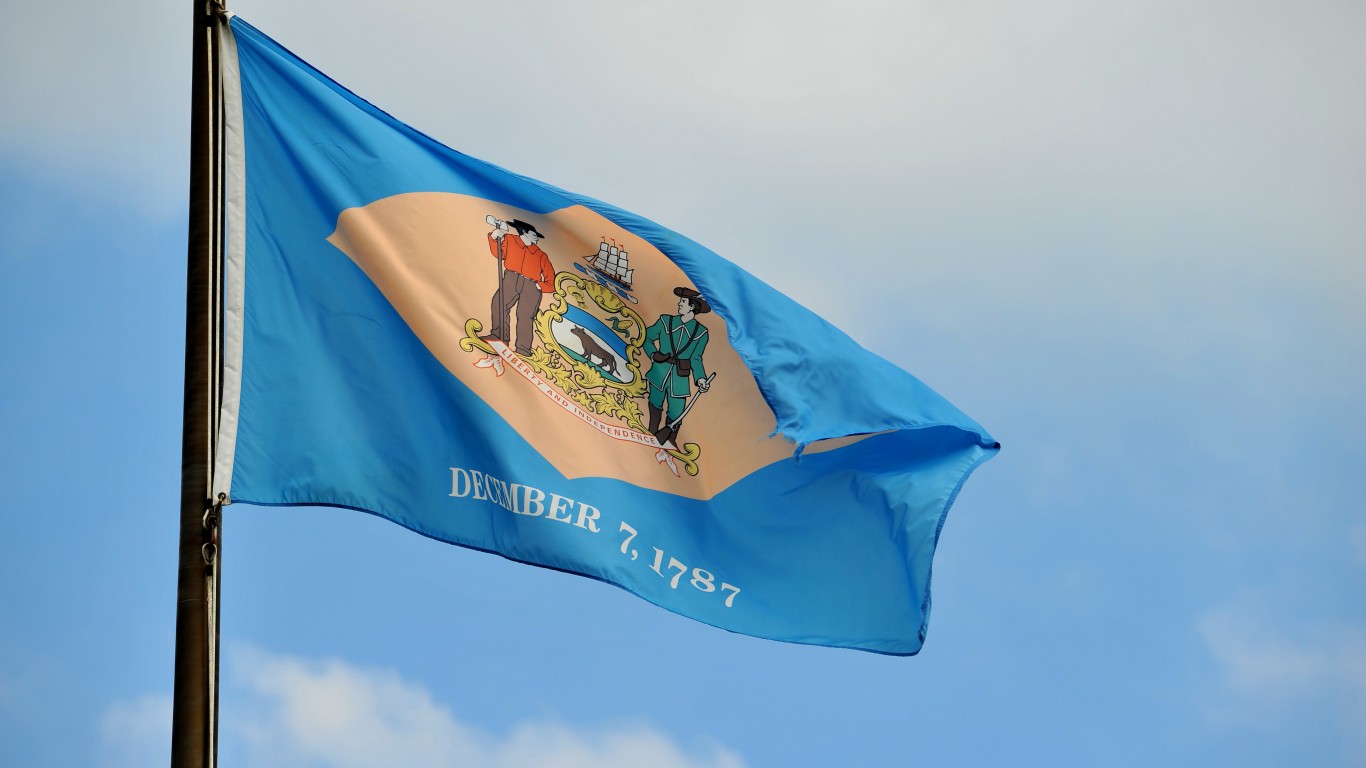
Delaware
> Flag design: A buff-colored diamond on colonial blue, with the state’s coat of arms
> Officially adopted on: 1913
The colonial blue and buff used on Delaware’s flag represent the colors of George Washington’s uniform. “December 7, 1787” is the date on which Delaware ratified the U.S. Constitution, becoming the first state of the Union. The coat of arms has several state symbols. The ship stands for the shipbuilding industry and coastal trade. The militiaman recognizes the importance of the citizen-soldier in maintaining American liberties. The water represents the Delaware River.

Florida
> Flag design: Two red bars on a white field, with the state seal in the center
> Officially adopted on: 1900
Florida’s state flag is very similar to Alabama’s state flag. The seal in the middle of the flag represents the state’s environmental features, including images of sun rays, palmetto trees, lakes, and rivers. Florida’s state flag is the only one to show a Native American woman.
There is some controversy over whether the addition of St. Andrew’s cross to Florida’s state flag was based primarily on the saltire in the Confederate battle flag, or merely an effort to reduce the older flag’s resemblance to a flag of surrender.
[in-text-ad-2]
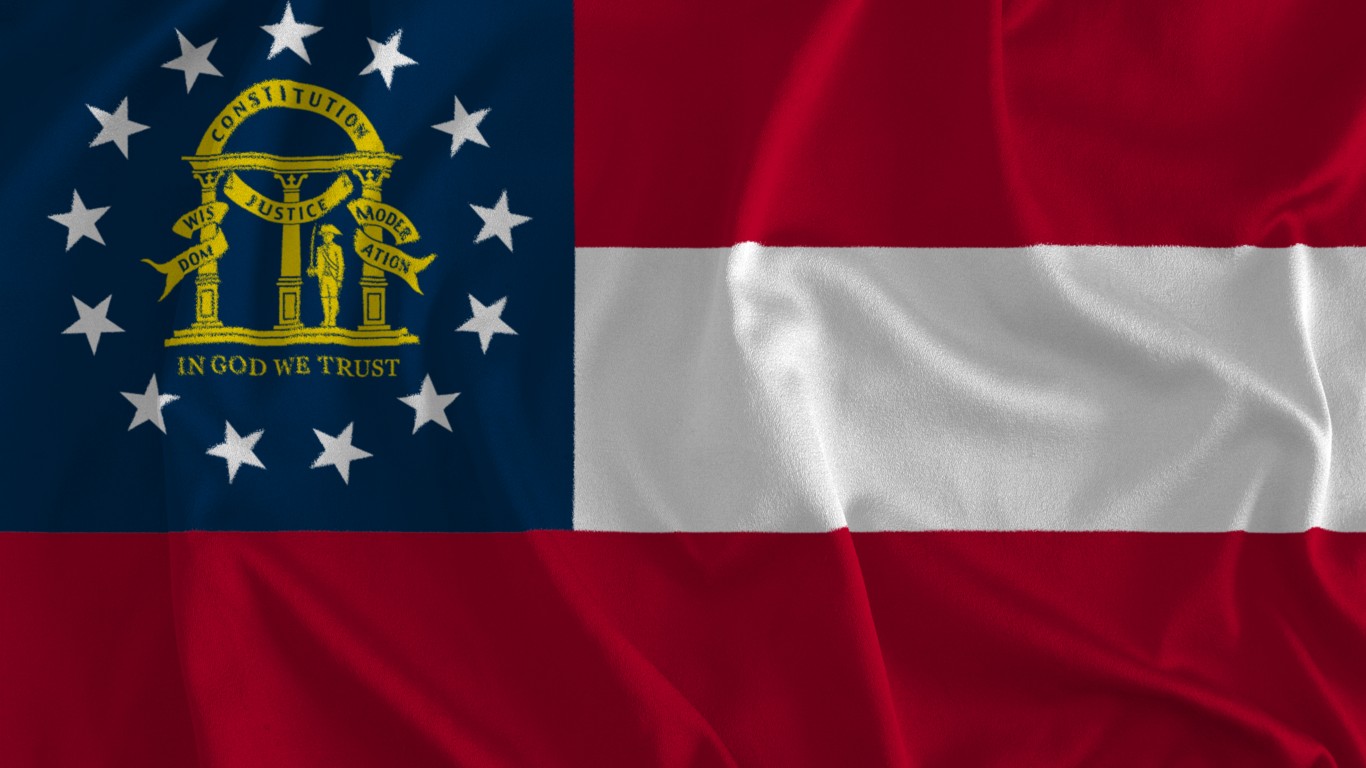
Georgia
> Flag design: 3 red-white-red stripes, a blue canton with a ring of 13 white stars around the state’s coat of arms in gold
> Officially adopted on: 2003
The 13 white stars circling Georgia’s coat of arms symbolize the state and the other 12 original colonies that formed the United States of America. The flag is reminiscent of the Confederate Stars and Bars, with three broad red-white-red stripes and a blue canton, a rectangular area, usually at the top corner that is nearest to the staff.
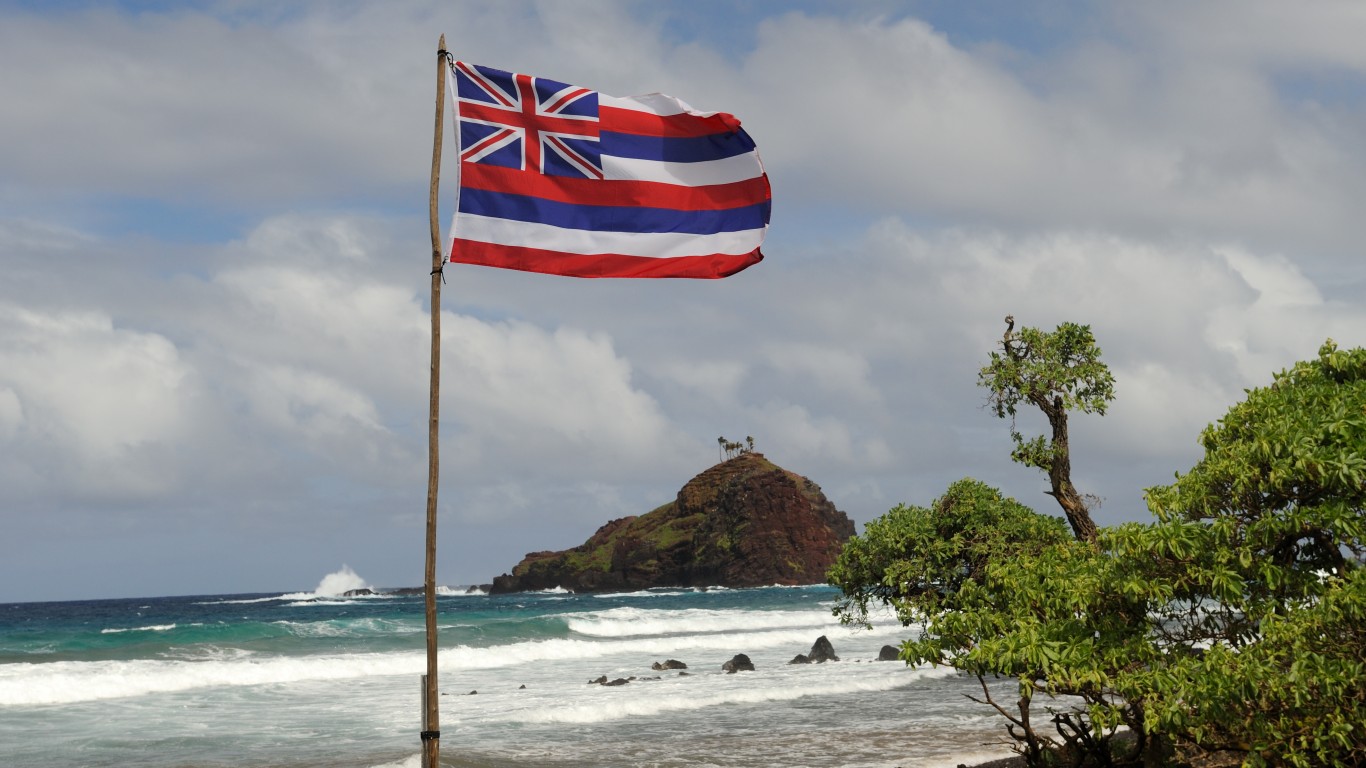
Hawaii
> Flag design: 8 alternating stripes of white, red, and blue, with the U.K.’s Union Flag in the canton
> Officially adopted on: 1845
Hawaii’s flag is the only state flag to include a foreign country’s national flag. The flag resembles the Union Jack of Great Britain because the islands were once under Britain’s control. The eight horizontal stripes represent the eight major islands that make up the state.
[in-text-ad]
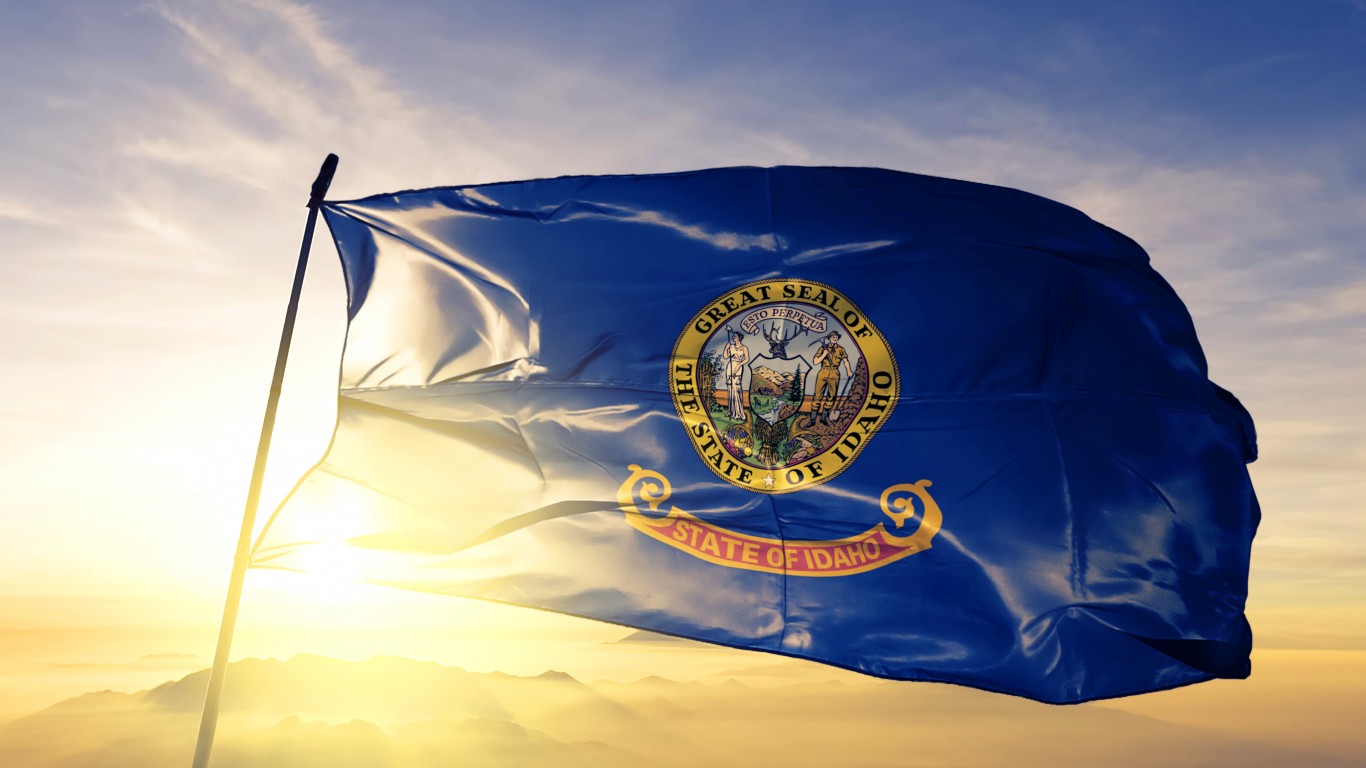
Idaho
> Flag design: State seal of Idaho on a field of blue
> Officially adopted on: 1907
The state seal in the center of the flag represents Idaho’s main industries — mining, agriculture, and forestry. The seal — the only one of all U.S. state seals that was designed by a woman — is also meant to emphasize the state’s geographic features, including mountains and lakes.
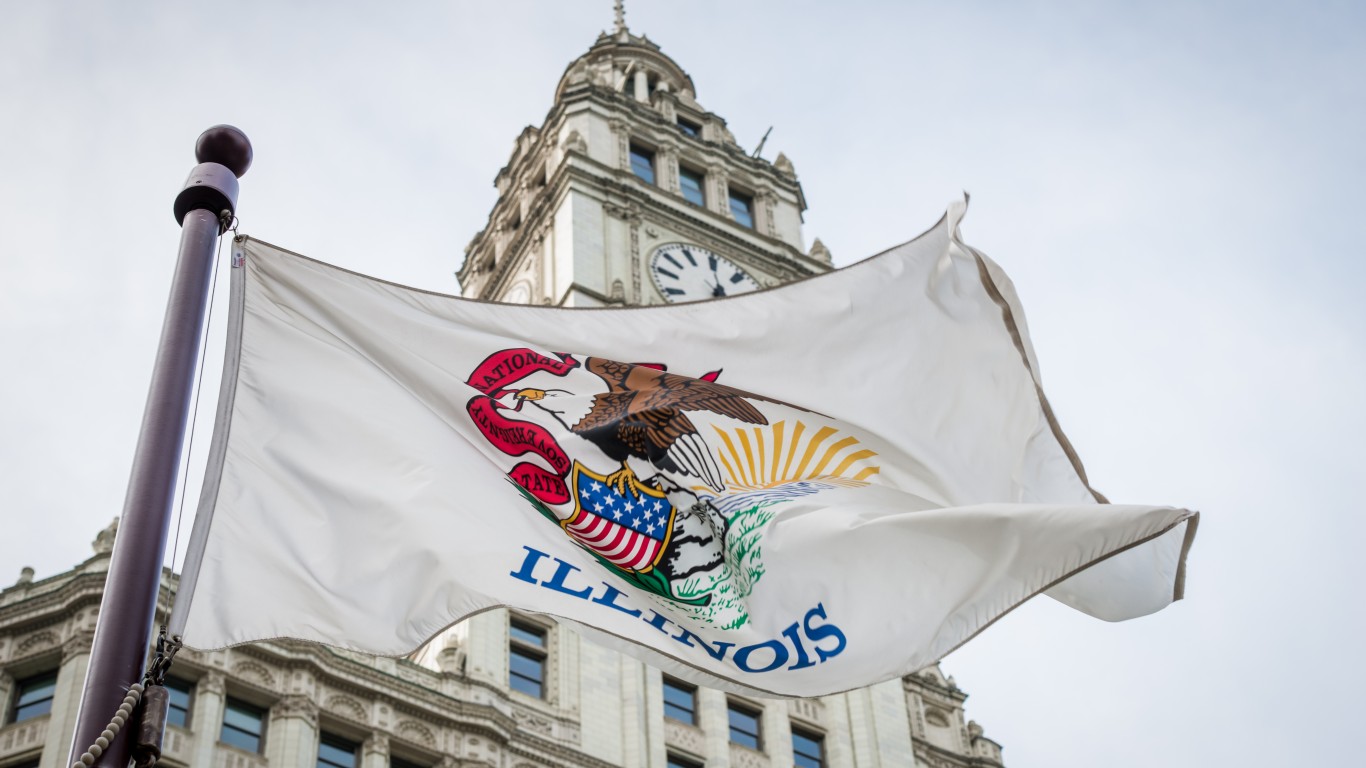
Illinois
> Flag design: State seal on a white background, with the word “Illinois” underneath the seal
> Officially adopted on: 1913
The flag’s design includes elements from the Illinois seal such as a rock on a stretch of land with water and a rising sun behind it. The seal also includes a shield bearing the national stars and stripes in the claws of a bald eagle. The ribbon reads the motto of Illinois: “State sovereignty — national union.” The 1818 and 1868 years stand for the years Illinois became a state and for the first use of the state seal, respectfully. The name of the state was added in 1969 to make the flag more recognizable.
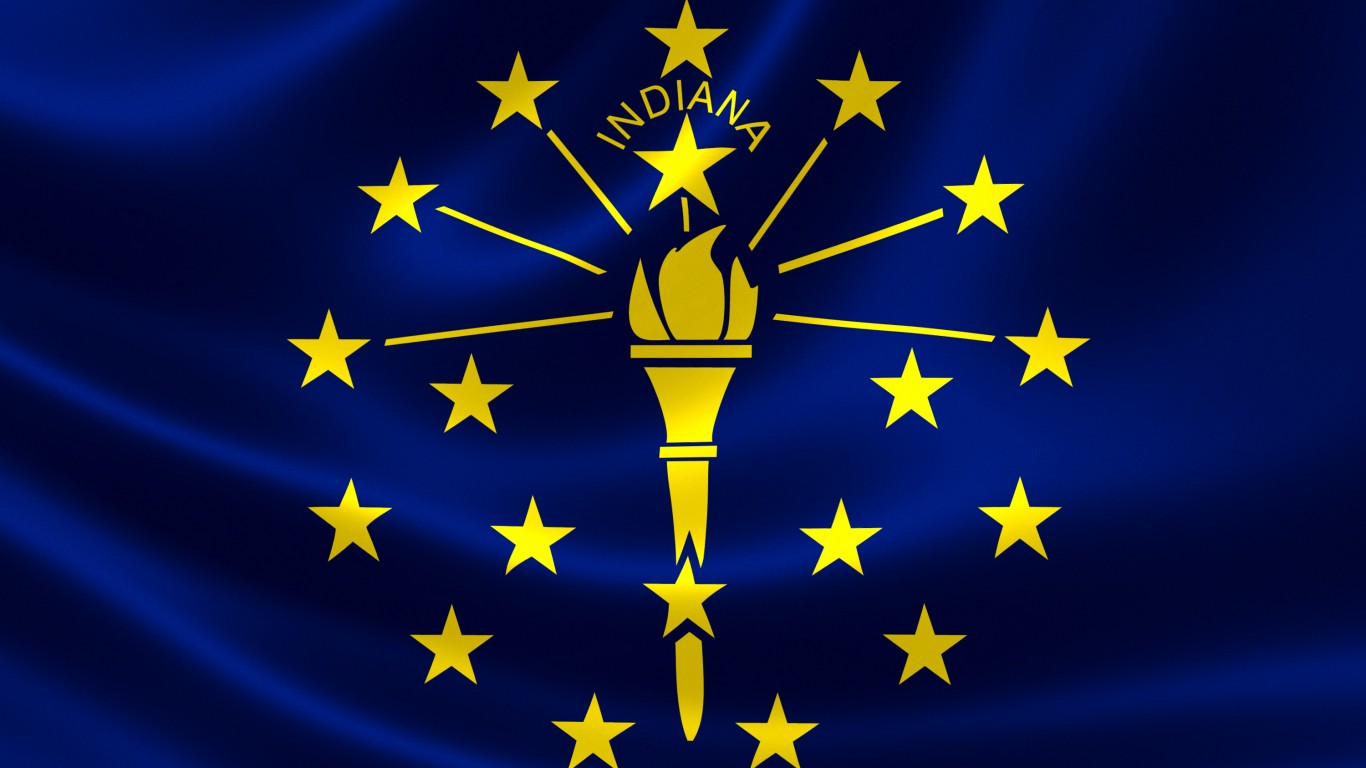
Indiana
> Flag design: A gold torch surrounded by 13 stars, an inner semi-circle of 5 stars, and a large star at the top, crowned by the word ‘Indiana’
> Officially adopted on: 1917
The torch in Indiana’s state flag is a symbol of liberty and enlightenment. The 13 stars in the outer circle symbolize the original 13 colonies. The five stars that make up the inner semi-circle represent the next five states to join the Union. The large star above the torch — and the 19th on the flag — is a symbol of Indiana becoming the 19th state.
[in-text-ad-2]
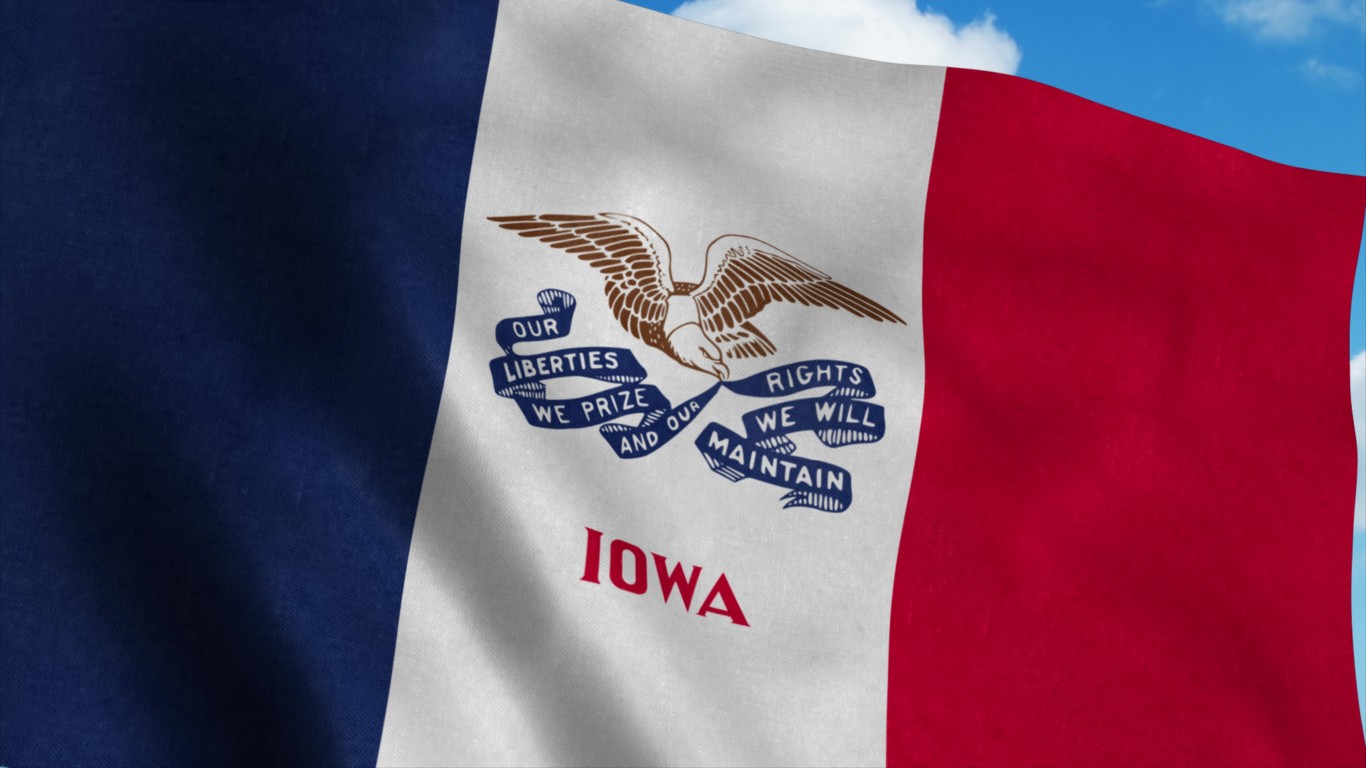
Iowa
> Flag design: A vertical tricolor consisting of blue, white, red, with an eagle holding a ribbon in the center
> Officially adopted on: 1921
Iowa’s flag was designed so that Iowa national guardsmen stationed at the Mexican border during World War I would have an emblem to represent them. The blue stripe stands for loyalty, justice, and truth, the white stands for purity, and the red for courage. The eagle carries streamers in its beak inscribed with the state’s motto: “Our liberties we prize and our rights we will maintain.”
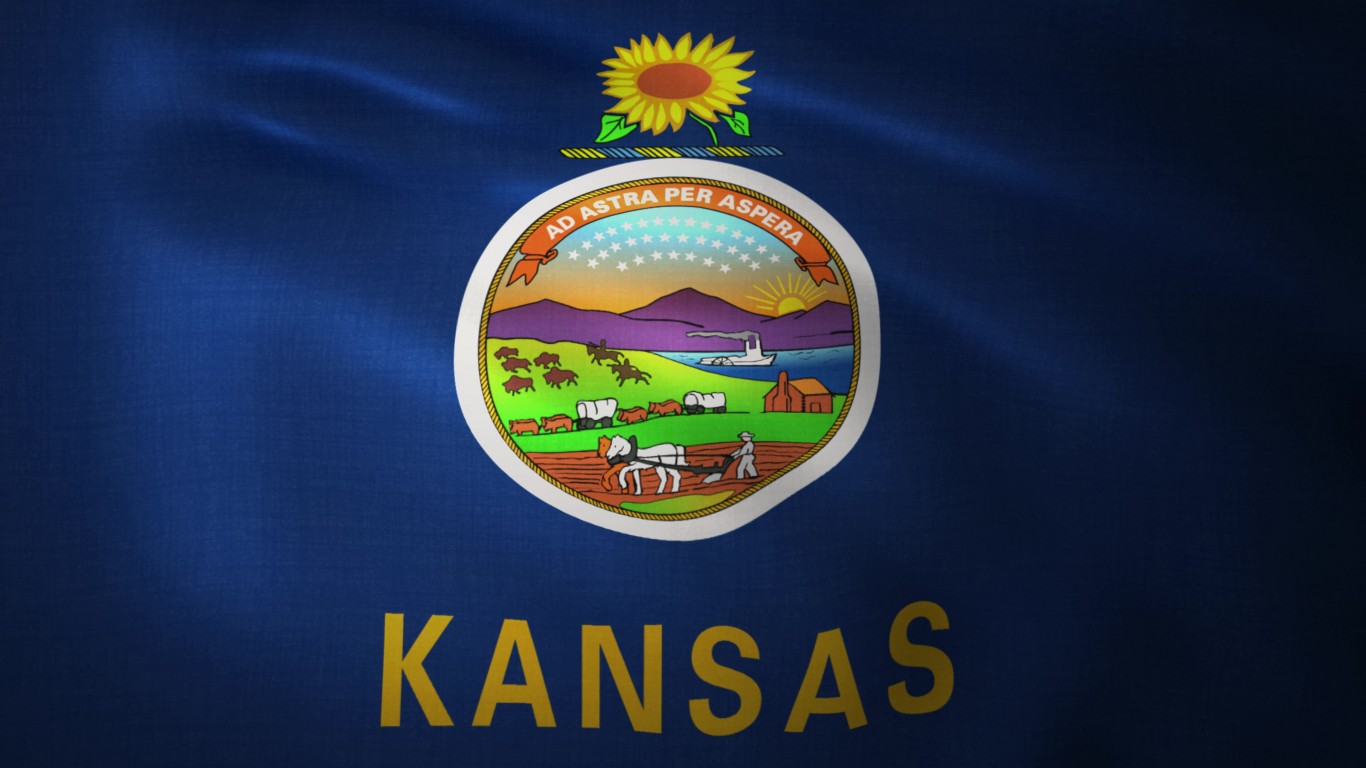
Kansas
> Flag design: State seal and a sunflower on a field of azure, displayed above the word ‘Kansas’
> Officially adopted on: 1927
The sunflower on the state’s flag is the official state flower of Kansas. The gold and blue bars represent the Louisiana Purchase, of which Kansas was part. The state seal contains the number 34 because Kansas was the 34th state to join the Union. A herd of buffalo is pursued by two Native Americans on horseback symbolizing the first people who settled Kansas. The plowed fields represent agriculture in the state.
[in-text-ad]
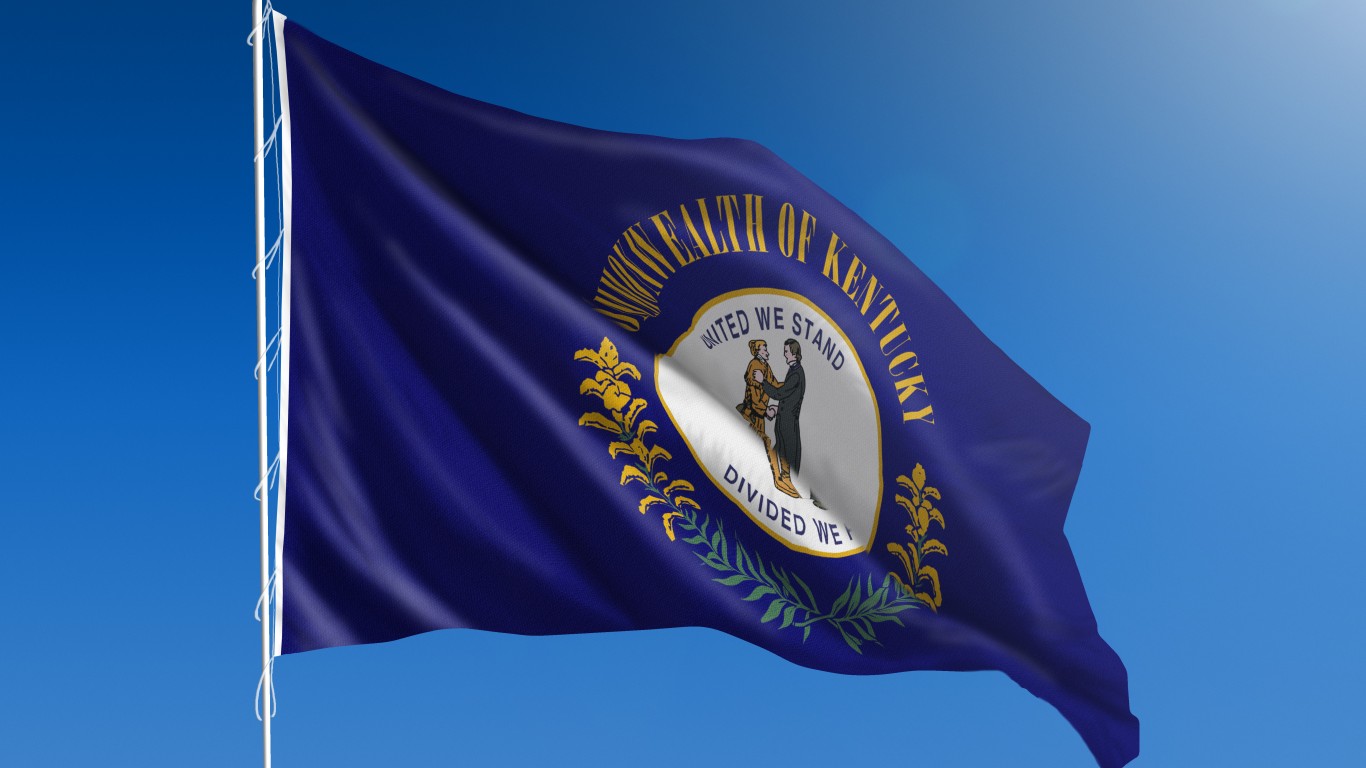
Kentucky
> Flag design: State seal, surrounded by the words ‘Commonwealth of Kentucky’ and sprigs of goldenrod on a navy blue field
> Officially adopted on: 1918
The two people on the seal, a frontiersman and a statesman, represent all the people of Kentucky, including country and city inhabitants of 1792, when the state was admitted to the Union. Hence, the state’s motto: “United we stand, divided we fall.”
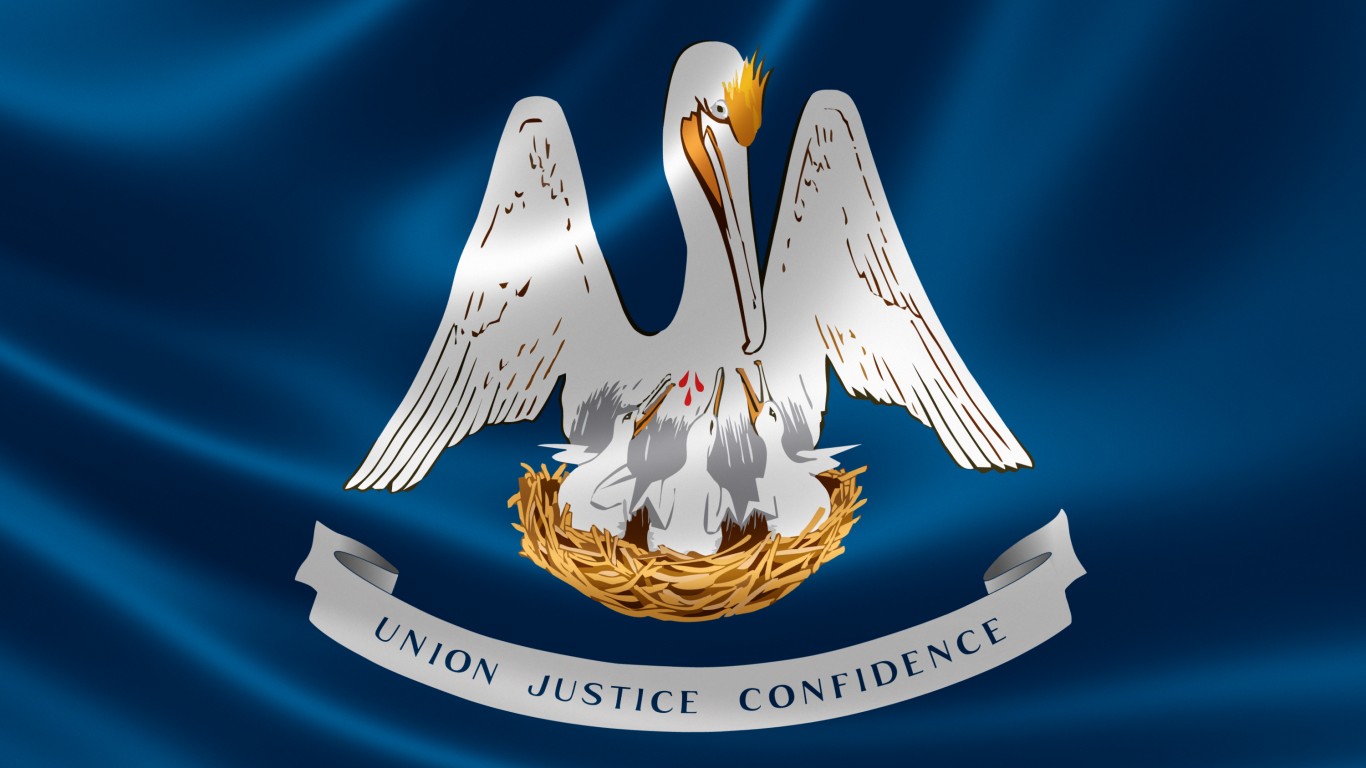
Louisiana
> Flag design: A pelican feeding her young with her own blood on a field of azure
> Officially adopted on: 1912
The state flag of Louisiana displays a white pelican, the state’s symbol since colonial times. The pelican is nurturing its young by tearing at its own breast — a symbol of sacrifice — which is signified by three drops of blood. The ribbon beneath contains the motto of the state: “Union, Justice and Confidence.”

Maine
> Flag design: State coat of arms on a blue field with a moose resting under a pine tree in the center and a farmer and a seaman on the sides
> Officially adopted on: 1909
The state’s flag features symbols of the natural richness of Maine, including a pine tree. White pine is Maine’s state tree, and “The Pine Tree State” is Maine’s nickname. The moose is the official state animal. The farmer is a symbol of pride in the state’s agricultural roots. The sailor represents Maine’s strong ties to the sea. The North Star is a symbol of guidance as travelers have used it for thousands of years to navigate.
[in-text-ad-2]
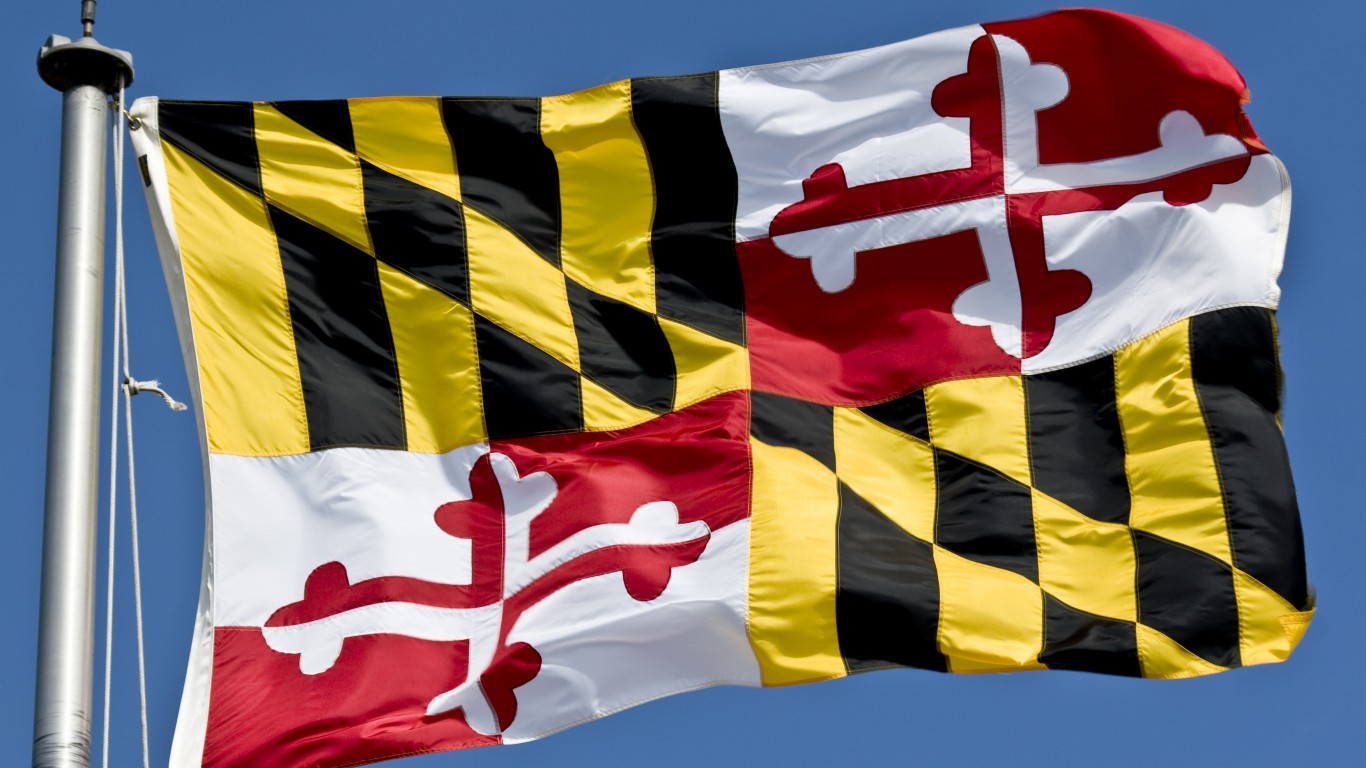
Maryland
> Flag design: 17th-century heraldic banner of arms of Cecil, 2nd Baron Baltimore
> Officially adopted on: 1904
The Maryland flag bears the coat of arms of the Calvert and Crossland families. The gold and black coat of arms stands for the Calvert family name of Lord Baltimore, who founded Maryland. During the Civil War the Calvert coat of arms represented the people of Maryland who wanted to remain in the Union. The red and white are the Crossland colors and represented Marylanders who sympathized with the South. After the war, residents started to use both coats of arms on flags at public events to help in the reconciliation effort.
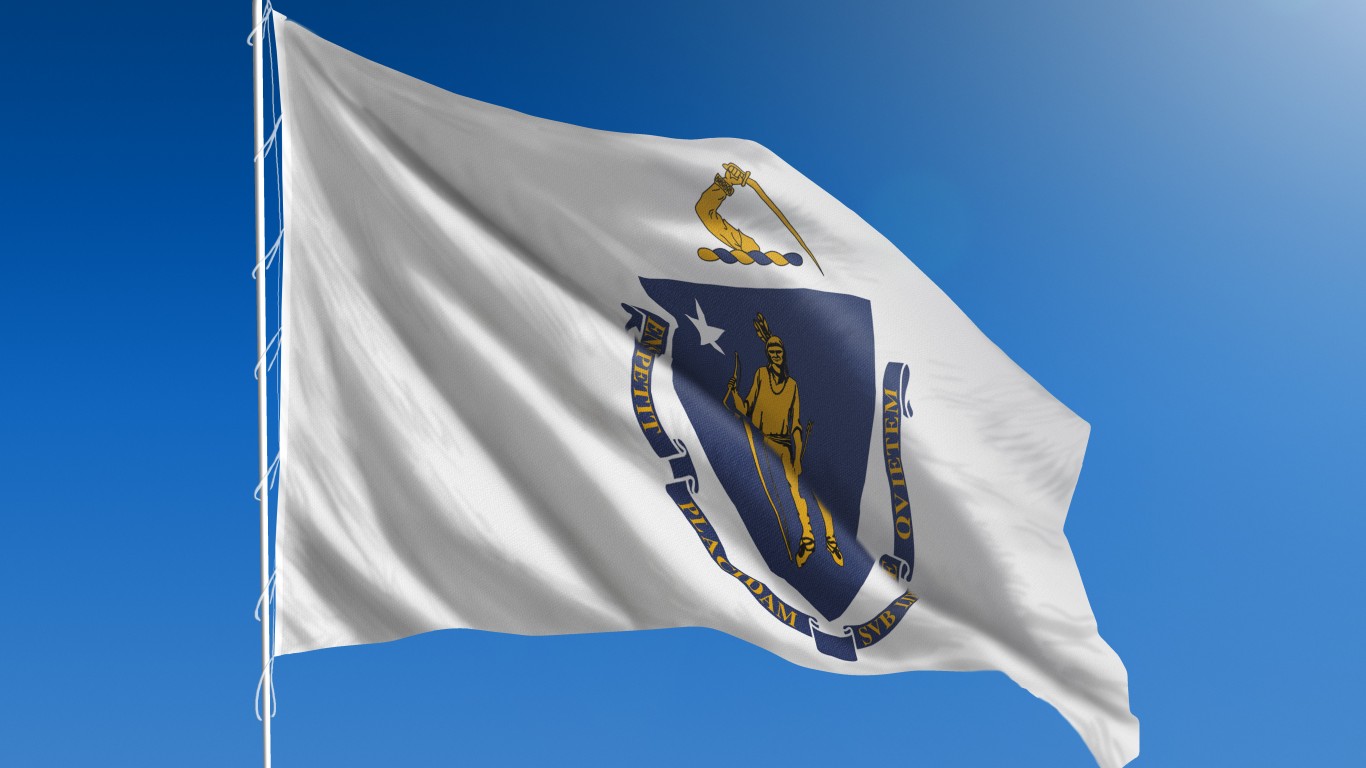
Massachusetts
> Flag design: The state coat of arms centered on a white field
> Officially adopted on: 1908
Massachusetts’ flag and state seal have been criticized as demeaning to Native Americans. The flag features the state’s coat of arms, which includes a Native American holding a bow and arrow. The arrow is pointed down, symbolizing peace. The white star represents the state as one of the original colonies. The ribbon is inscribed with the state motto in Latin, which means “By the sword we seek peace, but peace only under liberty.” The arm holding a sword with the blade up symbolizes Myles Standish, who protected the Plymouth colony during the revolutionary war, but he also killed many local Native Americans.
[in-text-ad]
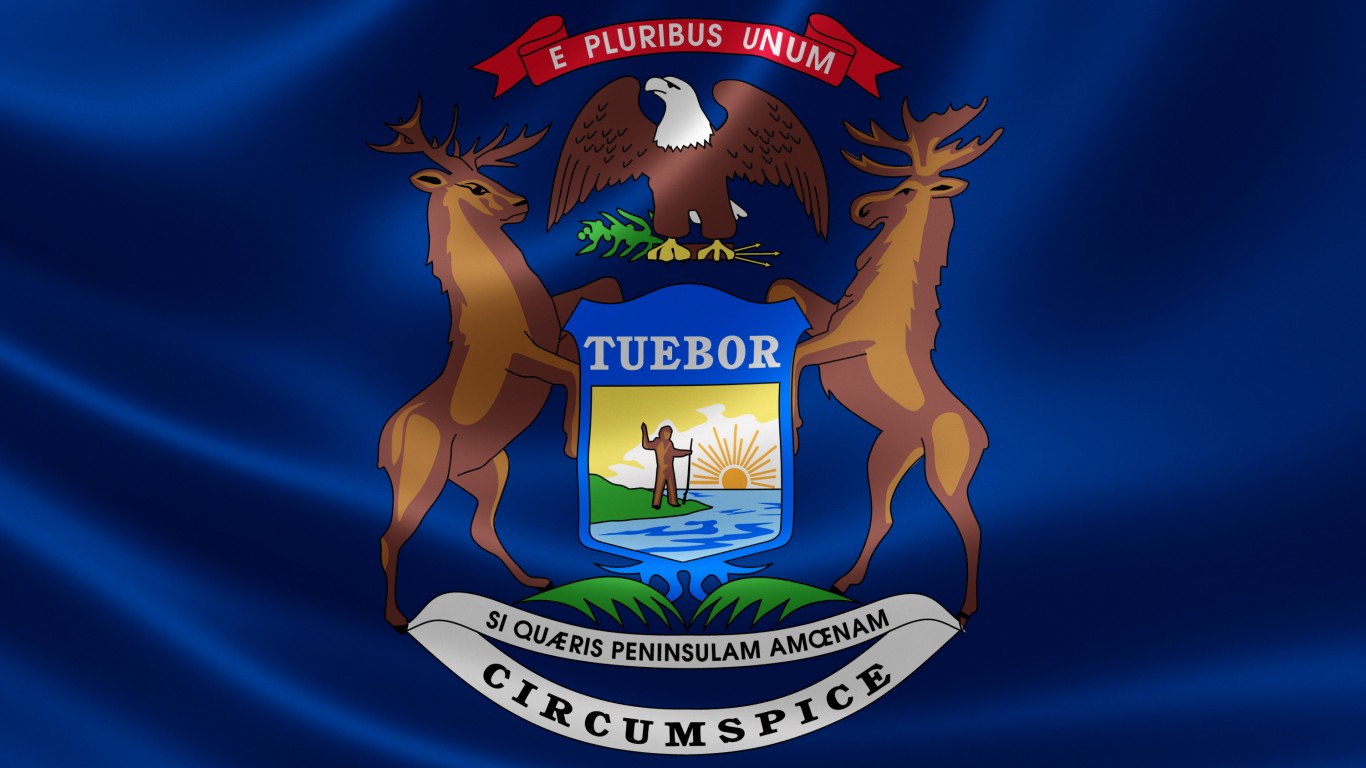
Michigan
> Flag design: The state’s coat of arms on a dark blue field
> Officially adopted on: 1911
The moose and elk, which are common in the state, represent Michigan and the bald eagle signifies the United States. The Latin phrase “E Pluribus Unum” means “From Many, One,” meaning the U.S. being one nation made from many states. “Tuebor” means “I Will Defend” and refers to the frontier position of Michigan. The flag also contains the state motto: “Si Quaeris Peninsulam Amoenam, Circumspice,” which means, “If you seek a pleasant peninsula, look about you.”
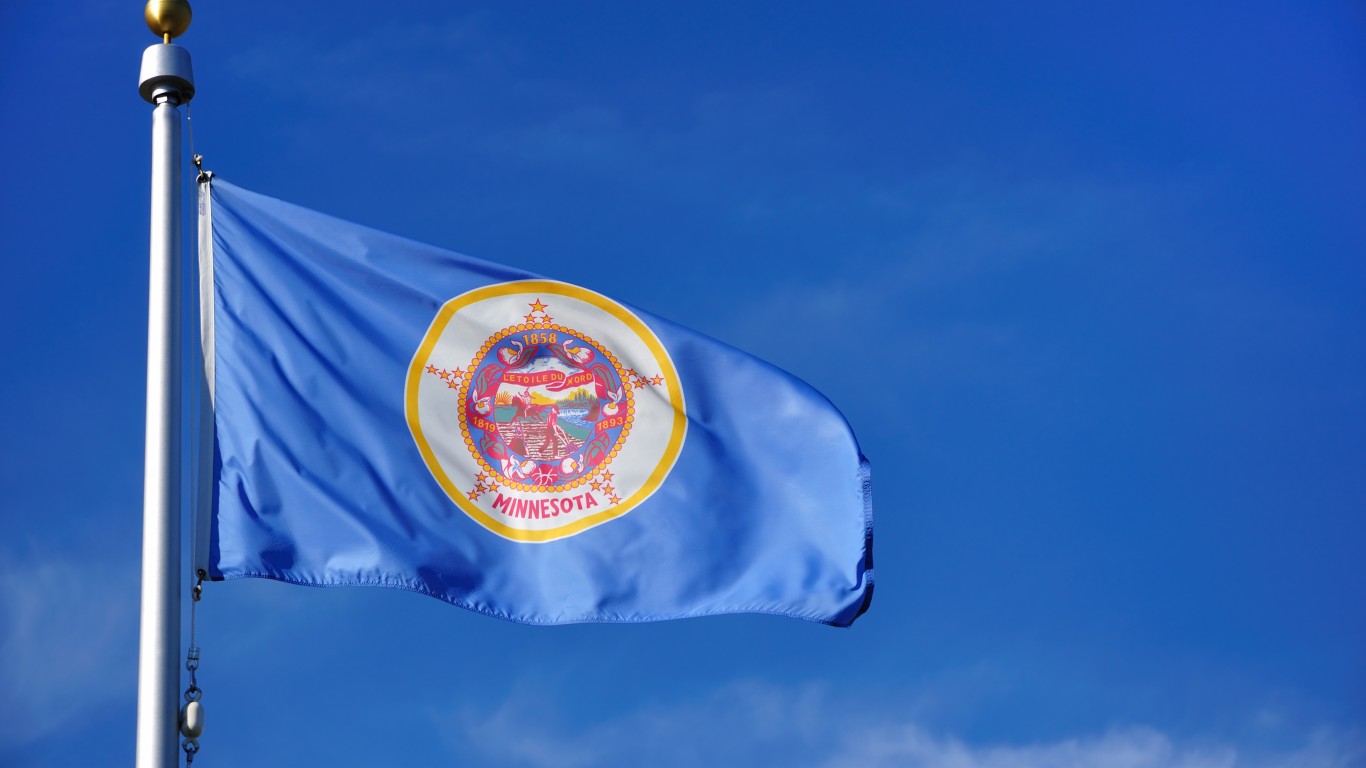
Minnesota
> Flag design: State seal on a medium blue field
> Officially adopted on: 1957
The three dates woven into the wreath surrounding the seal represent the year of statehood (1858), the year Fort Snelling was established (1819), and the year the original flag was adopted (1893). The 19 stars outside the wreath stand for Minnesota becoming the 19th state to enter the Union. The largest star at the top represents the North Star and Minnesota. The state motto is French: “L’étoile du Nord,” meaning “the star of the north,” hence the state’s nickname — The North Star State. The Native American on horseback represents the Native American heritage of Minnesota. The stump is a symbol of the lumber industry in the state.
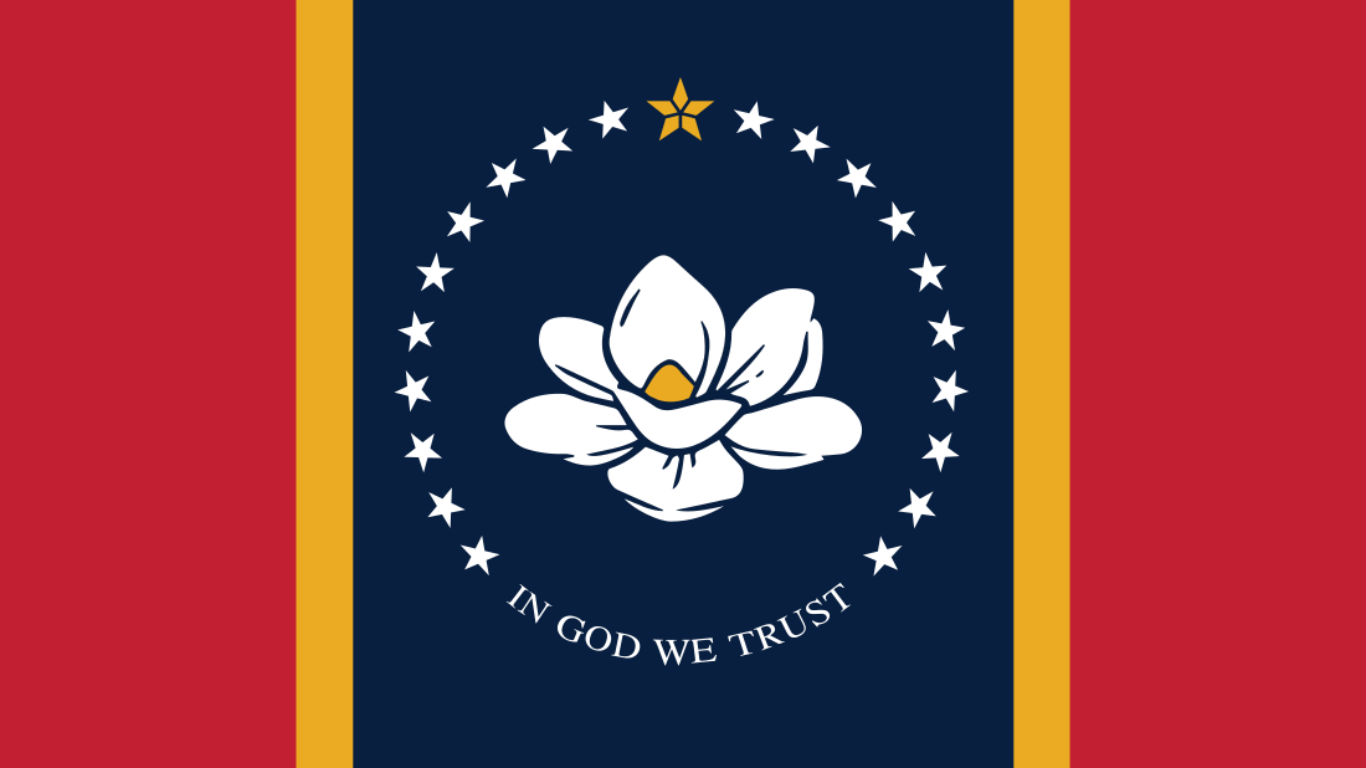
Mississippi
> Flag design: A white magnolia blossom and the words ‘In God We Trust’ on a red field with a gold-bordered blue pale
> Officially adopted on: January 2021
Mississippi residents voted in November 2020 to replace the 126-year-old Confederate-themed state flag, which featured the Confederate battle symbol. The new flag will include a white magnolia blossom, which has been used as a symbol of the state and its hospitality for decades. The flower is circled by 20 stars, representing Mississippi’s admission to the Union as the 20th state.
[in-text-ad-2]

Missouri
> Flag design: 3 tribands of red, white, and blue with the arms of Missouri in the center, bordered by a wide band of blue with 24 white stars
> Officially adopted on: 1913
The red stripe on Missouri’s flag is a symbol of bravery, the white stripe a symbol of purity, and the blue stripe a symbol of justice. The center of the flag displays Missouri’s state seal surrounded by 24 stars because Missouri became the 24th state. The two grizzly bears are symbols of courage and strength. They stand on a scroll bearing the state motto in Latin: “Salus Populi Suprema Lex Esto,” which means, “Let the welfare of the people be the supreme law.” Above the shield is a helmet representing Missouri’s state sovereignty. The cloud around the stars indicates the difficulties Missouri experienced in becoming a state.
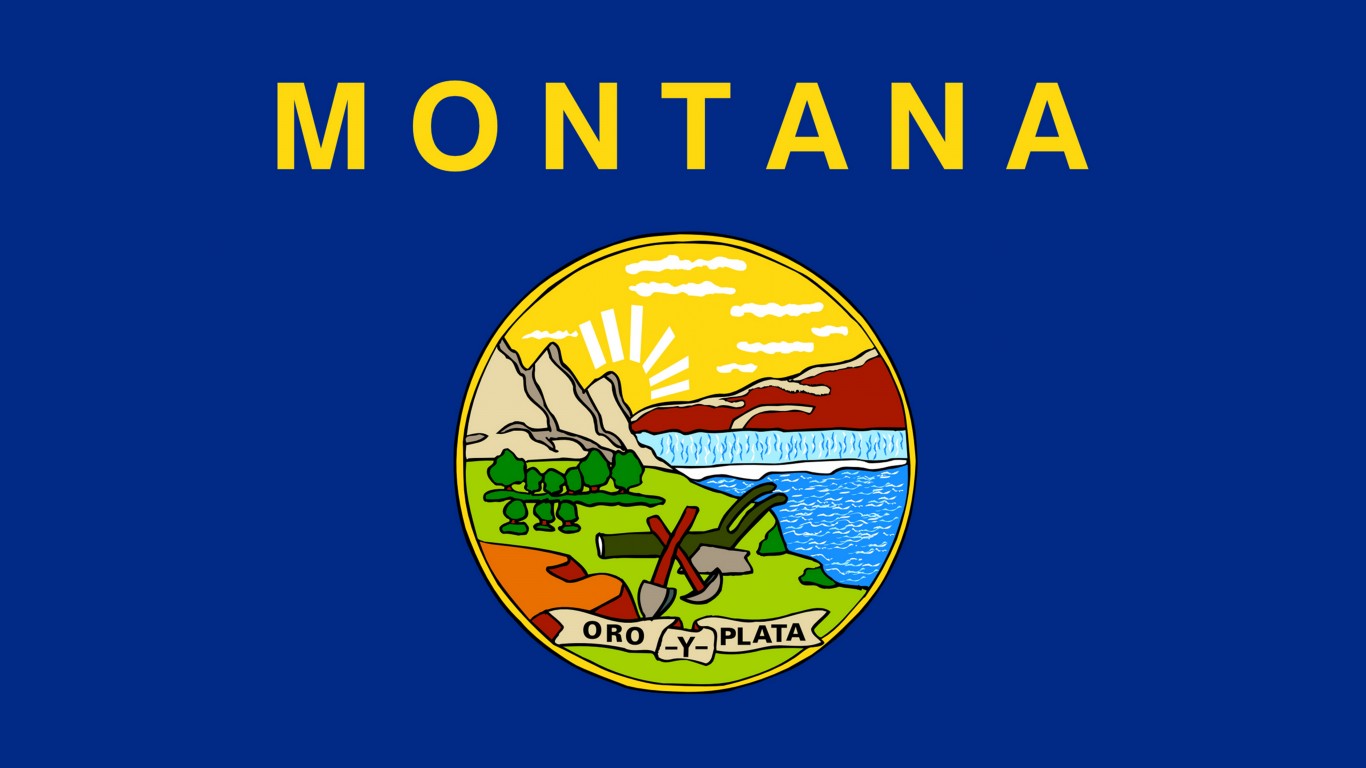
Montana
> Flag design: Seal of Montana on a blue field with the word ‘Montana’ above
> Officially adopted on: 1981
The state seal on its flag displays symbols of Montana’s history and environment. A sunrise shines over snowy mountains. Additionally, waterfalls, the Missouri River, mountains, hills, trees, and cliffs are featured behind a pick, a shovel, and a plow, which are tools that symbolize the state’s mining and farming history. A ribbon with the state motto in Spanish â “Oro y Plata,” meaning “gold and silver” â is at the bottom of the seal.
[in-text-ad]
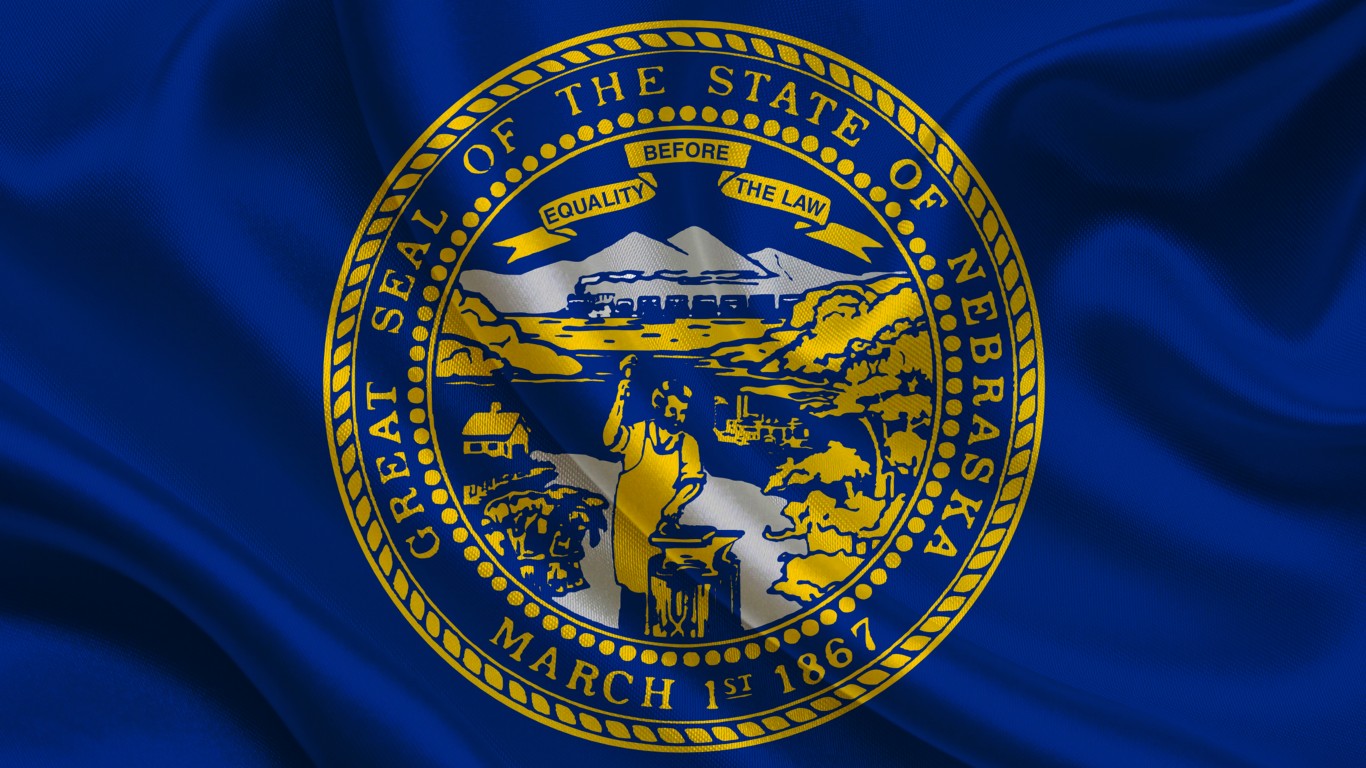
Nebraska
> Flag design: Seal of Nebraska in gold on an azure field
> Officially adopted on: 1925
Nebraska’s banner has been designated as the official state flag. The eastern part of the circle on the state seal features a steamboat ascending the Missouri River. The seal also features a settlers’ cabin, sheaves of wheat, and stalks of growing corn that represent agriculture. The train cars on the flag are meant to head towards the Rocky Mountains. The state motto, “Equality Before the Law,” also appears on the flag.
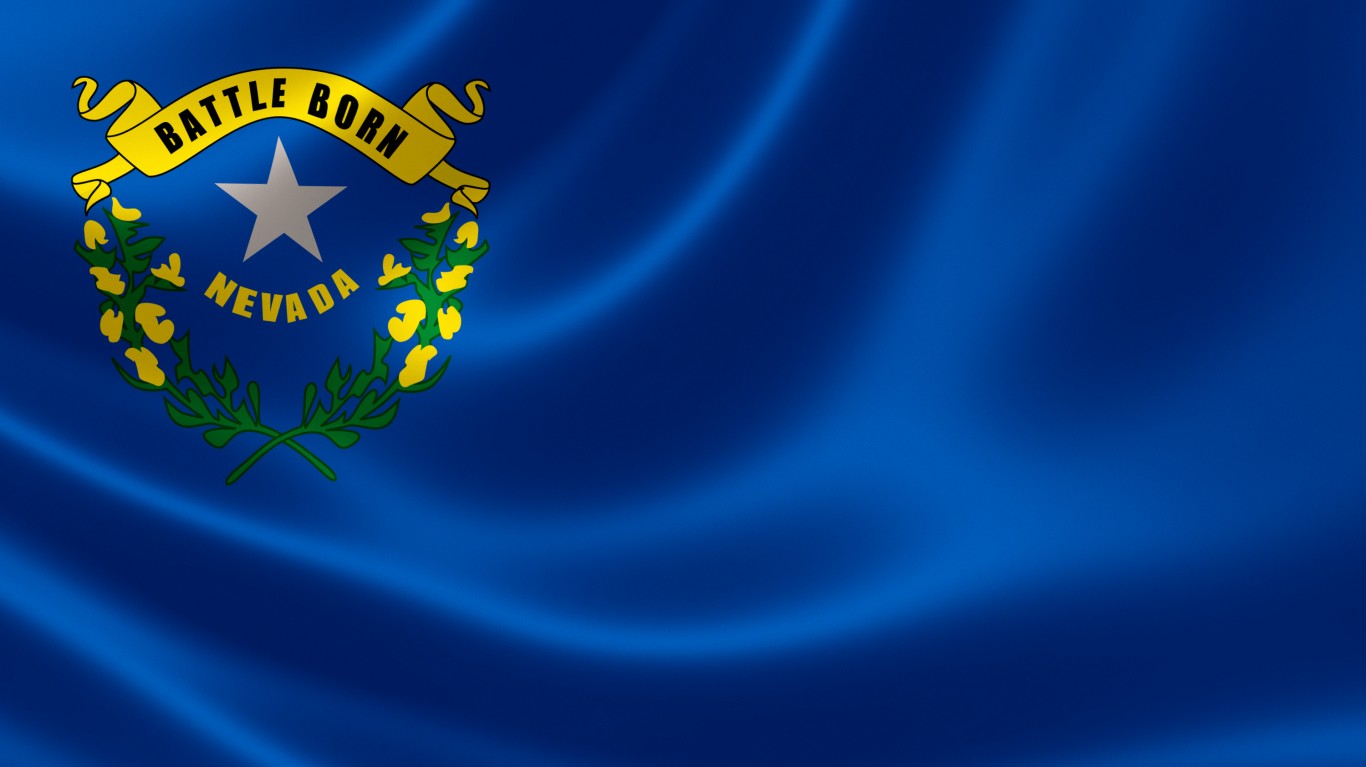
Nevada
> Flag design: Solid cobalt blue field with 2 sagebrush branches around a silver star with ‘Nevada’ and ‘Battle Born’
> Officially adopted on: 1991
Nevada has had four state flags in its history. The first flag was adopted in 1905, and the current flag was approved in 1991. The current flag has a cobalt blue background with a five-pointed silver star symbolizing the state metal — silver. The star is between branches of sagebrush, the state’s flower, that cross to form a half-wreath. The phrase “Battle Born” refers to Nevada joining the Union during the Civil War.
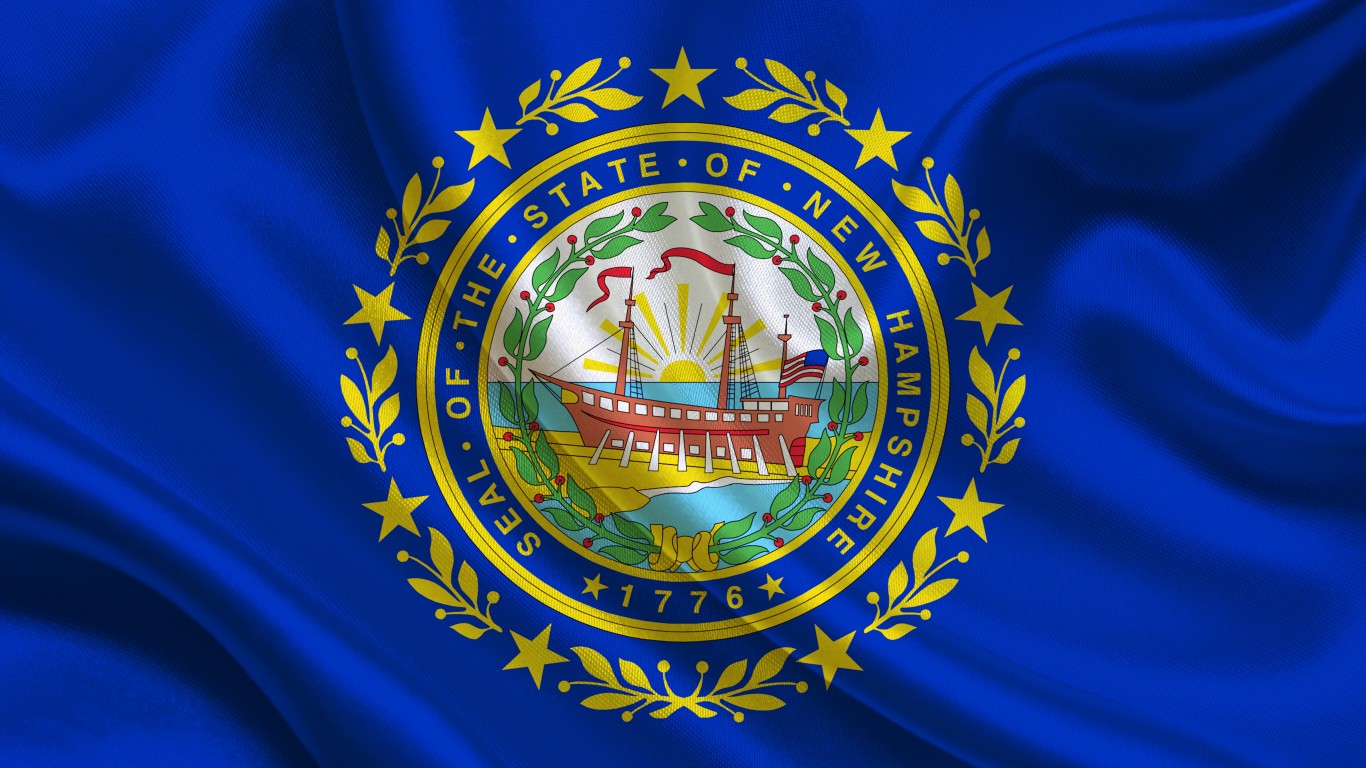
New Hampshire
> Flag design: The state seal centered on a blue background
> Officially adopted on: 1931
New Hampshire’s state flag features the state seal with the frigate Raleigh surrounded by laurel leaves and nine stars against a field of blue, signifying the rank of New Hampshire as the ninth state to ratify the U.S. Constitution and officially become a state.
[in-text-ad-2]
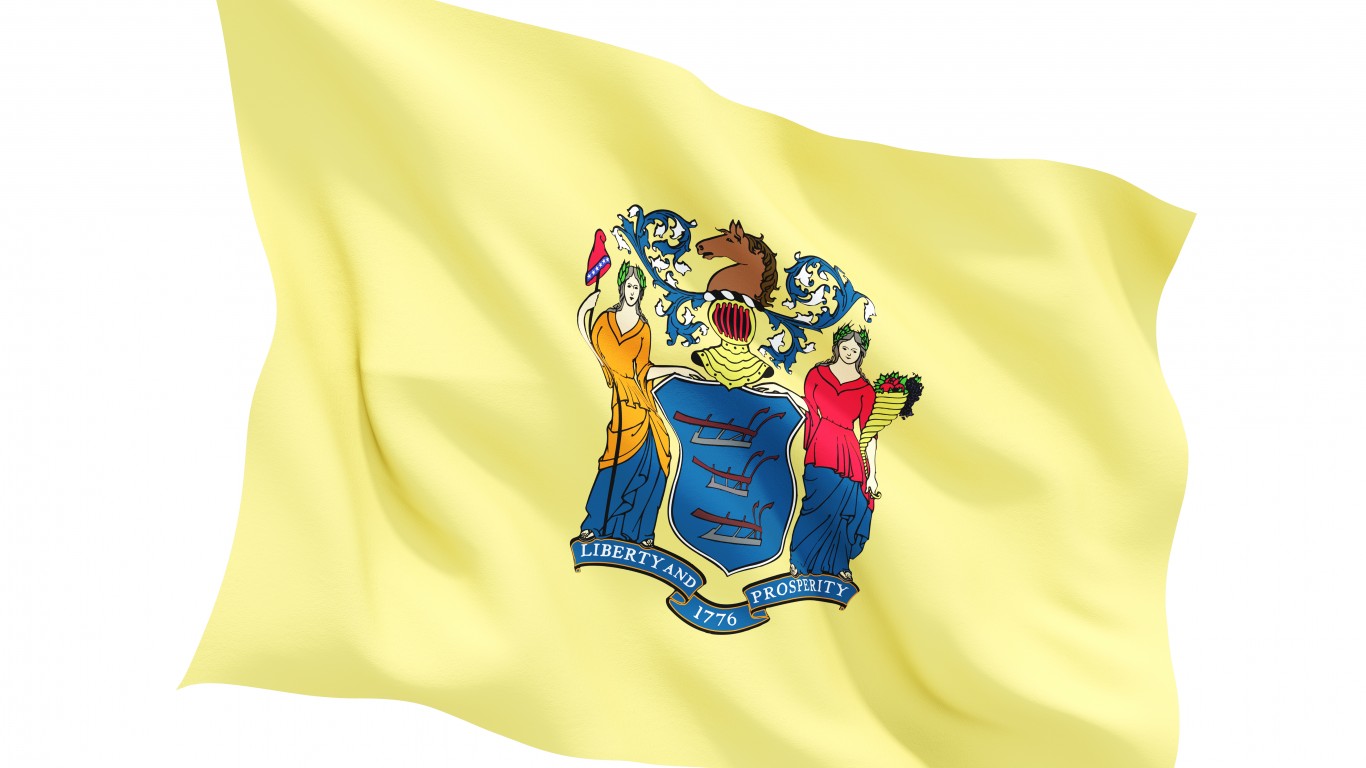
New Jersey
> Flag design: The coat of arms of the state on a buff-colored background
> Officially adopted on: 1896
The state flag represents the state colors, which were selected by General George Washington during the Revolutionary War. The three plows on the shield honor the state’s agricultural tradition. The helmet above the shield denotes sovereignty. The crest above the helmet is a horse’s head — the horse is New Jersey’s official state animal. The supporting female figures are Liberty and Ceres, the Roman goddess of grain and a symbol of fruitfulness.
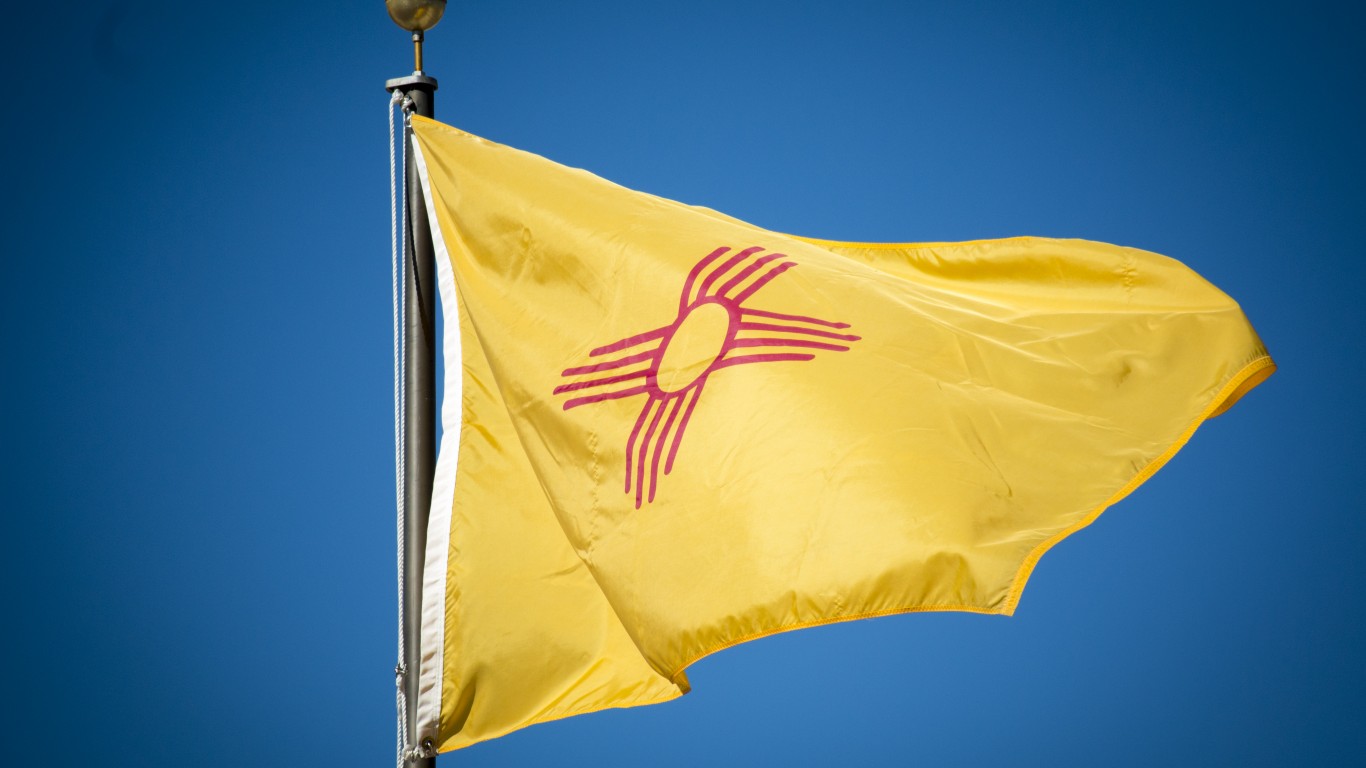
New Mexico
> Flag design: A red sun symbol of the Zia people on a field of gold
> Officially adopted on: 1925
The colors on the state flag are the red and yellow of the Spanish flag — the territory was part of Spanish Empire until the 19th century. The symbol of the ancient Zia sun represents the character of New Mexico. The Zia Indians of New Mexico view the sun, shown in the form of a red circle with rays pointing in four directions, as sacred. Four is the sacred number of the Zia, meaning the four points of the compass, the four seasons of the year, the four periods of each day, and the four stages of life.
[in-text-ad]

New York
> Flag design: State seal in the middle of dark blue field
> Officially adopted on: 1901
The center shield in the design of the flag displays a ship and a sloop on the Hudson River, symbolizing commerce. Liberty and Justice support the shield, and Liberty’s left foot treads on a crown, which represents freedom from Great Britain. Justice is blindfolded, symbolizing impartiality and fairness. A banner shows New York’s state motto in Latin, “Excelsior,” which means “ever upward.”
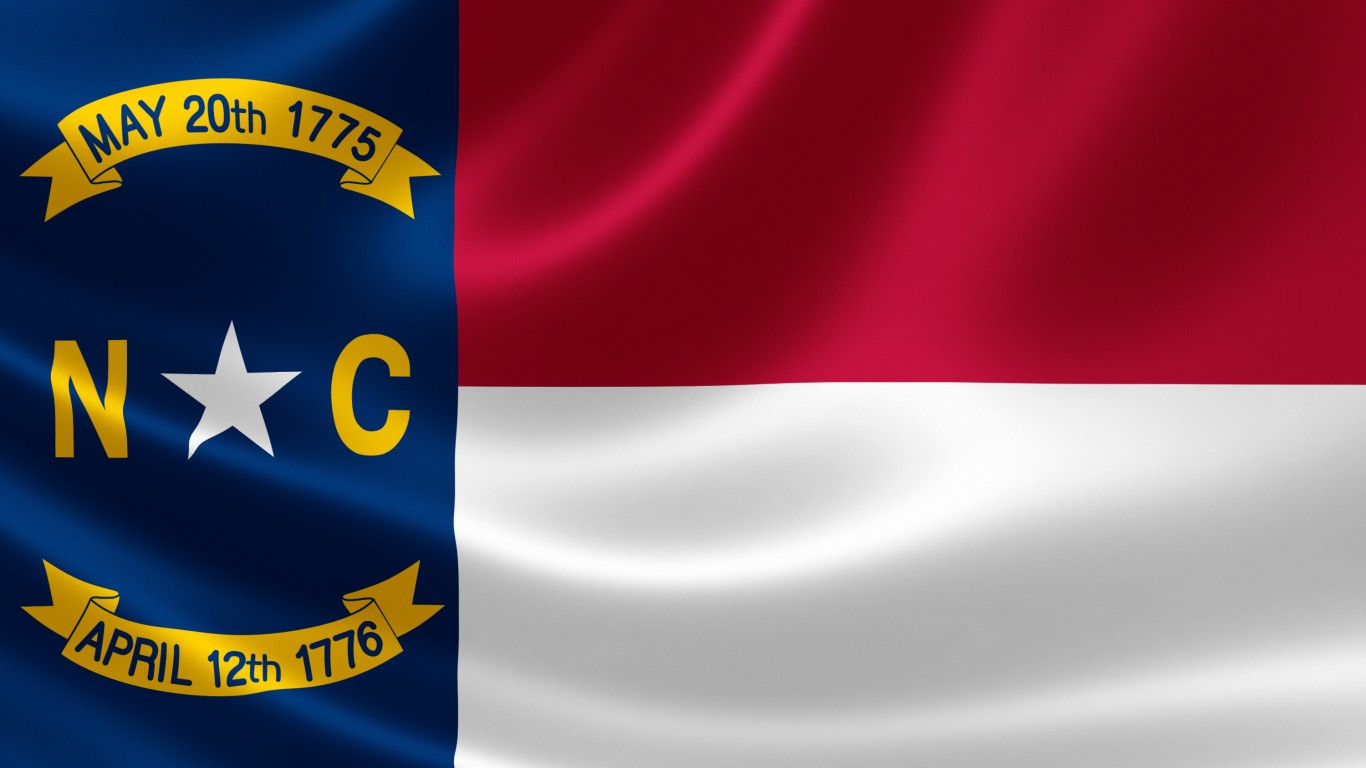
North Carolina
> Flag design: A blue union, with white star in the middle, an ‘N’ in gilt on the left, and ‘C’ in gilt on the right
> Officially adopted on: 1885
The date May 20, 1775, on the upper ribbon on the flag is believed to refer to the Mecklenburg Declaration of Independence. April 12th, 1776, on the bottom ribbon commemorates the Halifax Resolves, a document that places North Carolina in the front rank of those that demanded unconditional freedom and absolute independence from any foreign power.
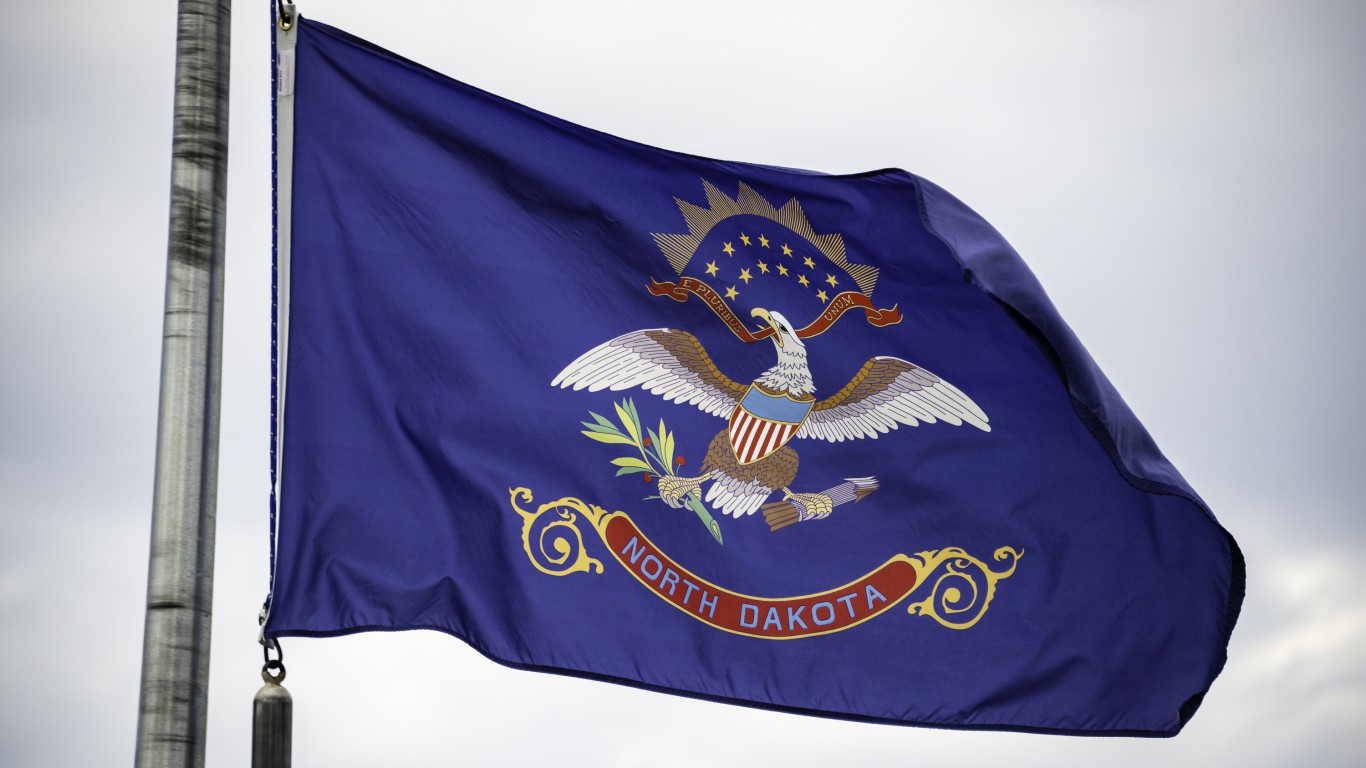
North Dakota
> Flag design: Banner carried by the state’s troop in the Philippine-American War
> Officially adopted on: 1911
The olive branch that the bald eagle is holding on North Dakota’s state flag is a symbol of peace. The eagle carries a ribbon in its beak that reads the state motto, “E Pluribus Unum,” which is Latin for “out of many, one,” referring to the U.S. A shield with 13 stripes on the eagle’s breast represents the original colonies. The state flag conforms to the color, design, and size of the regimental flag used by North Dakota Infantry in the Spanish-American War in 1898.
[in-text-ad-2]
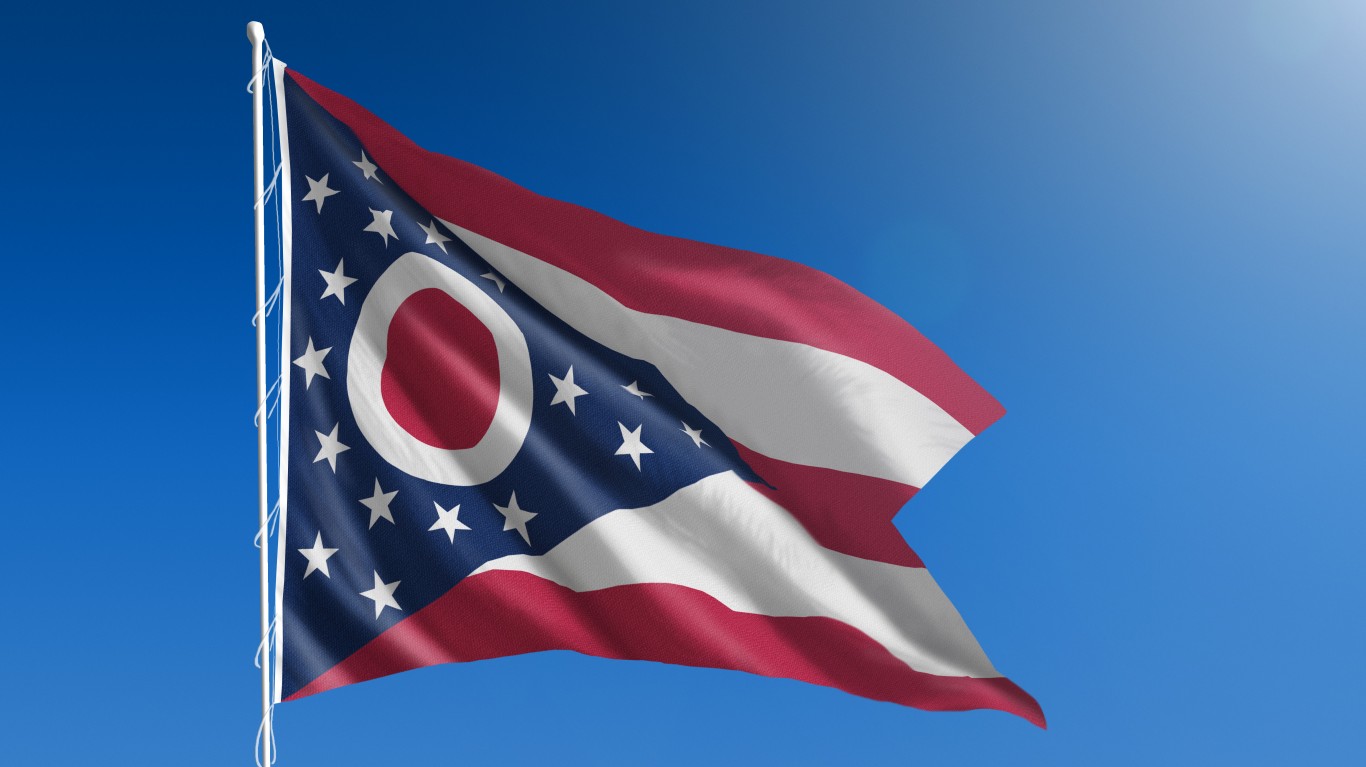
Ohio
> Flag design: 5 stripes alternating between red and white with an azure chevron containing a white and red ‘O’ and 17 white stars
> Officially adopted on: 1902
The unique swallowtail design of Ohio’s state flag was the creation of John Eisemann. The blue triangular field represents the state’s hills and valleys. The flag has 17 white stars — 13 around the circle for the original colonies and four at the apex of the triangle to raise to 17, representing Ohio as the 17th state to join the Union. The red and white stripes represent the roads and waterways of the state.
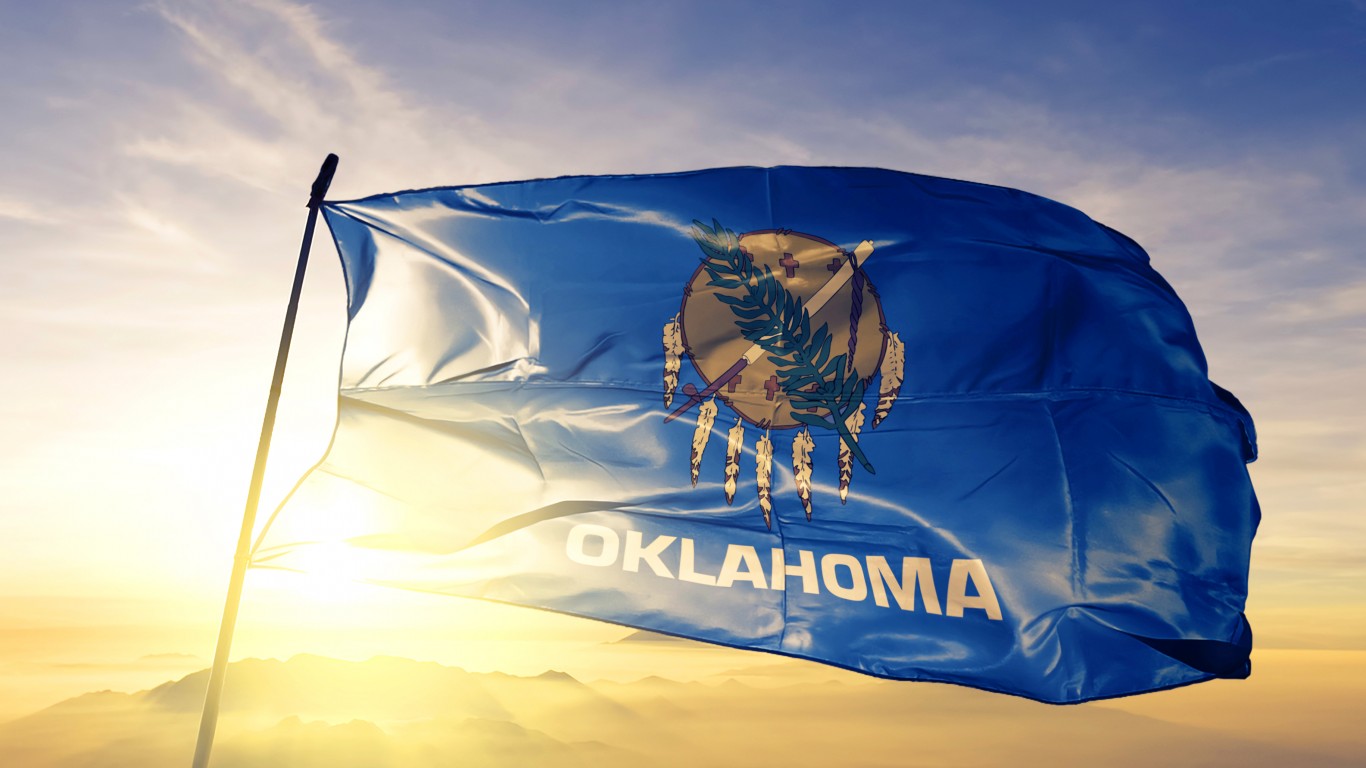
Oklahoma
> Flag design: Buffalo-skin shield with 7 eagle feathers on a sky blue field
> Officially adopted on: 1925
The blue field that is the background of Oklahoma’s flag signifies devotion. The shield is a symbol of defensive or protective warfare. The olive branch, representing settlers, and the peace pipe, representing Native Americans, appear on top of the shield.
[in-text-ad]
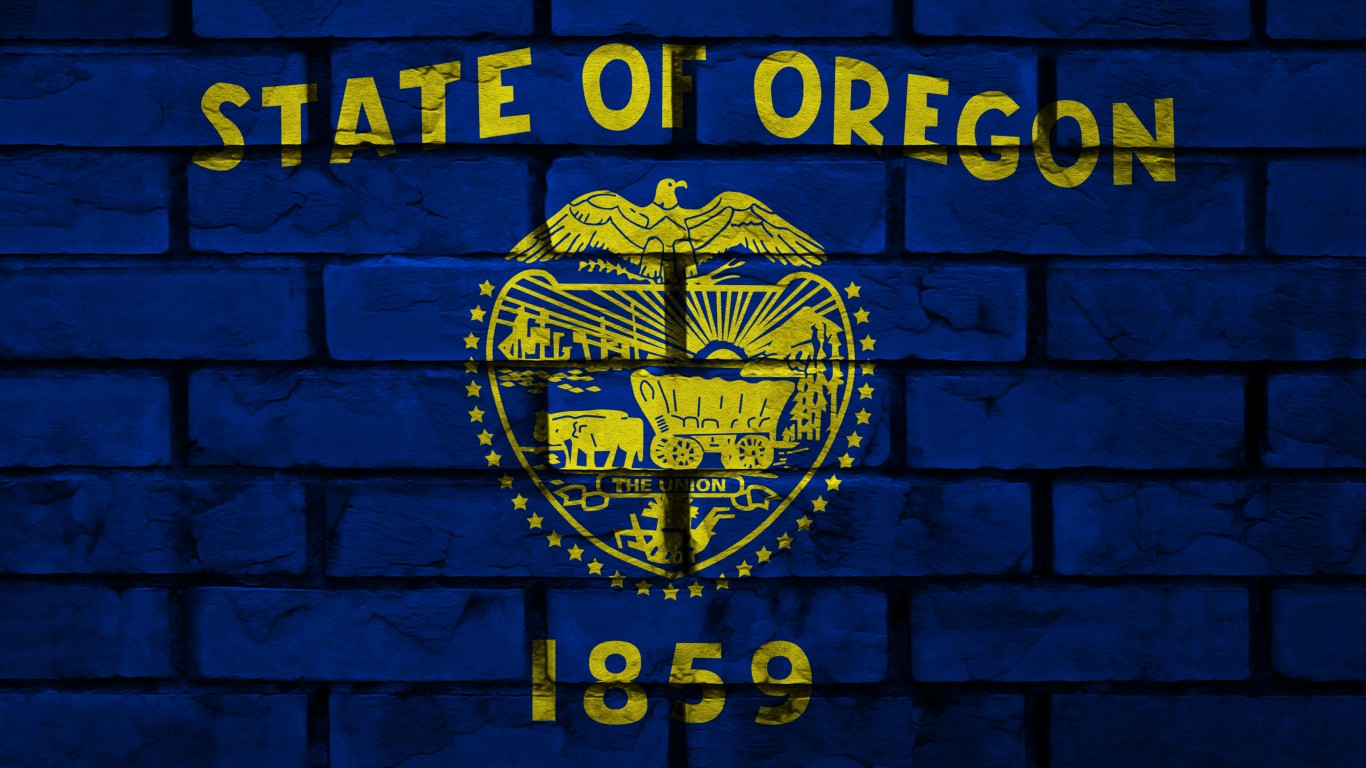
Oregon
> Flag design: State seal in gold on a navy blue field
> Officially adopted on: 1925
The Oregon state flag is the only U.S. state flag that displays different images on the front and the back. The flag has gold lettering and symbols on a field of navy blue, which are Oregon’s state colors. The front displays part of the state seal. The “1859” stands for the year Oregon was admitted to the Union. The symbols on the shield include the mountains and forests of Oregon, a departing British war ship, which represents Great Britain no longer having any influence, and an arriving American ship, which symbolizes the rise of American power. The 33 stars around the shield signify that Oregon was the 33rd state to join the Union. The back of the flag has a beaver, the official state animal.
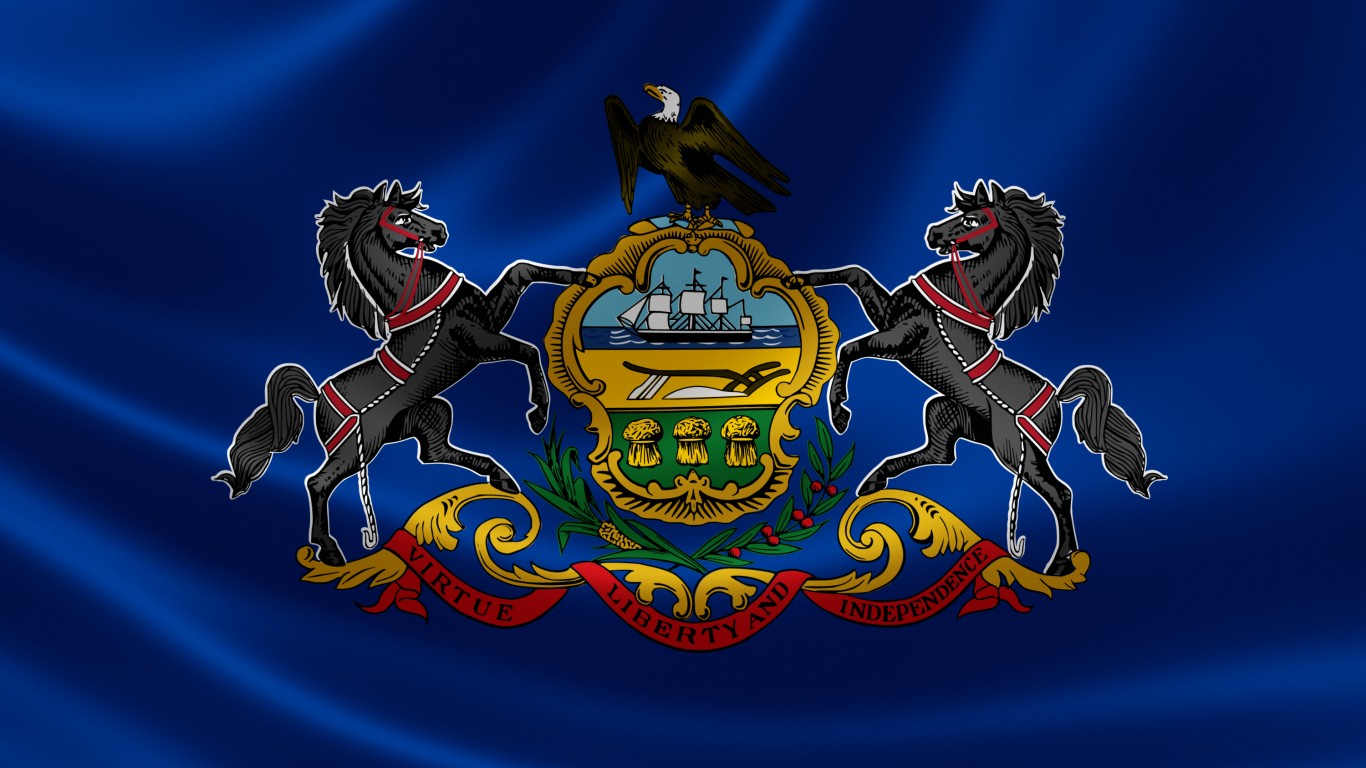
Pennsylvania
> Flag design: State coat of arms on a field of blue
> Officially adopted on: 1907
Pennsylvania’s flag features the state coat of arms represented by a ship and wheat sheaves, representing commerce and agriculture. The two horses standing on their hind legs symbolize strength. The state motto — “Liberty, Virtue, Independence” — appears on a ribbon at the base of the design.
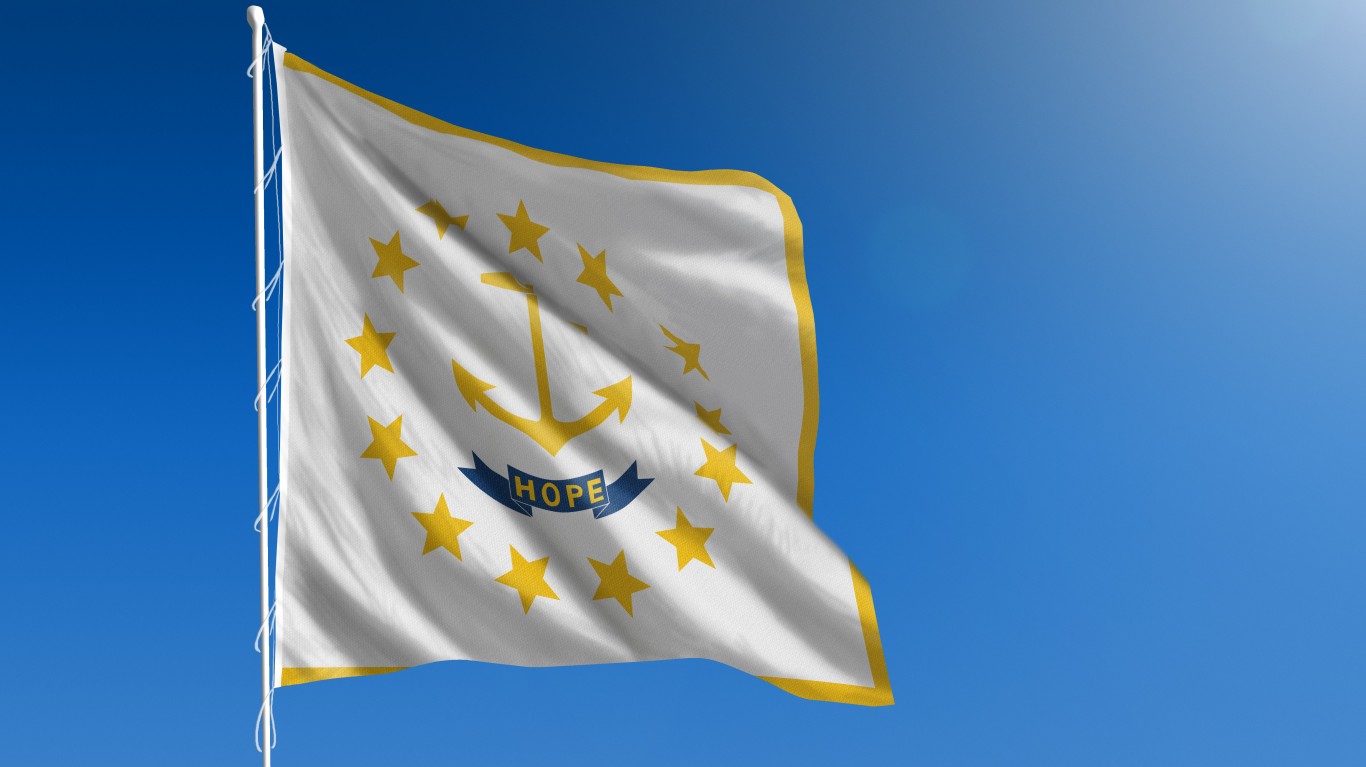
Rhode Island
> Flag design: A gold anchor, surrounded by 13 gold stars, on a field of white, with a blue ribbon below the anchor reading ‘hope’
> Officially adopted on: 1877
Rhode Island’s flag features a gold anchor and blue ribbon with the state motto, “Hope,” surrounded by 13 golden stars, symbolizing the original 13 states. The use of the word “Hope” is believed to have been inspired by the biblical phrase, “Hope we have as an anchor of the soul.”
[in-text-ad-2]
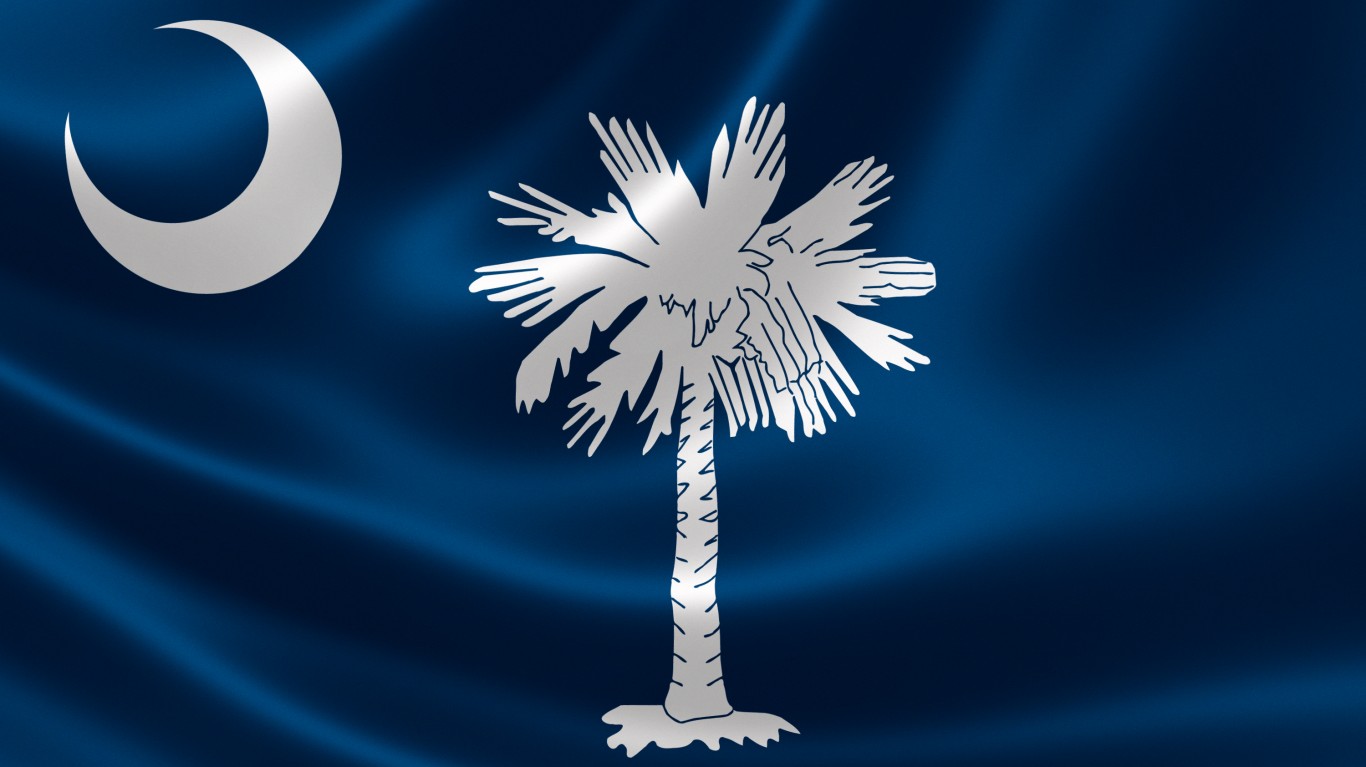
South Carolina
> Flag design: A white palmetto tree on an indigo field and a white crescent on the top left
> Officially adopted on: 1861
The crescent symbol on the state flag stands for the silver emblem worn on the caps of South Carolina troops during the Revolutionary War. The background blue color matches the blue of their uniforms. The flag also features the state tree — palmetto. The tree also appears on the state seal. The symbol of the tree pays homage to the palmetto fort on Sullivan’s Island during the war.
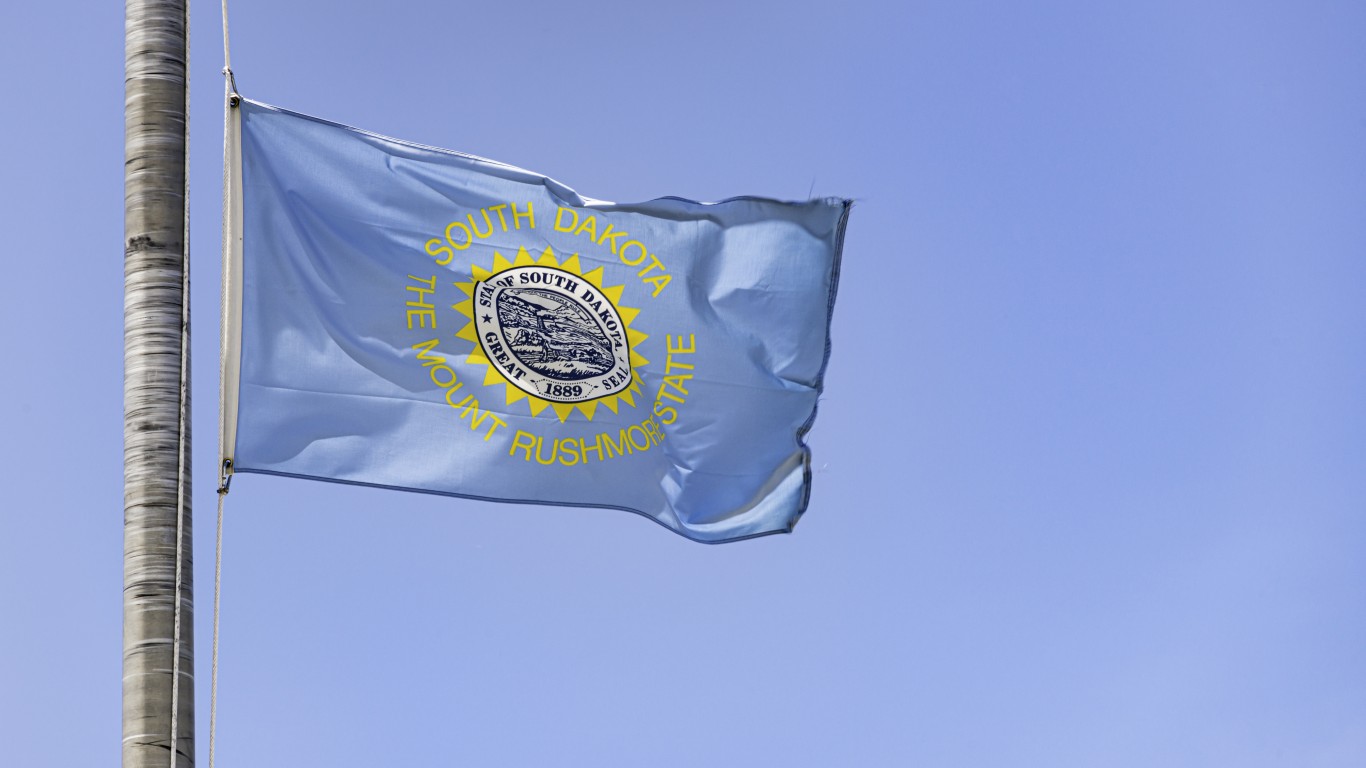
South Dakota
> Flag design: State seal on a sky blue field, with gold triangles and inscriptions of ‘SOUTH DAKOTA’ and ‘THE MOUNT RUSHMORE STATE’
> Officially adopted on: 1992
The state seal on South Dakota’s flag symbolizes the state’s commerce, industry, and natural resources, which South Dakota has been known for. The state motto, “Under God the People Rule,” appears with a background of sky and hills. In the foreground, a steamship navigates a river running through agricultural and industrial land. The “1889” stands for the year South Dakota officially became a state.
[in-text-ad]
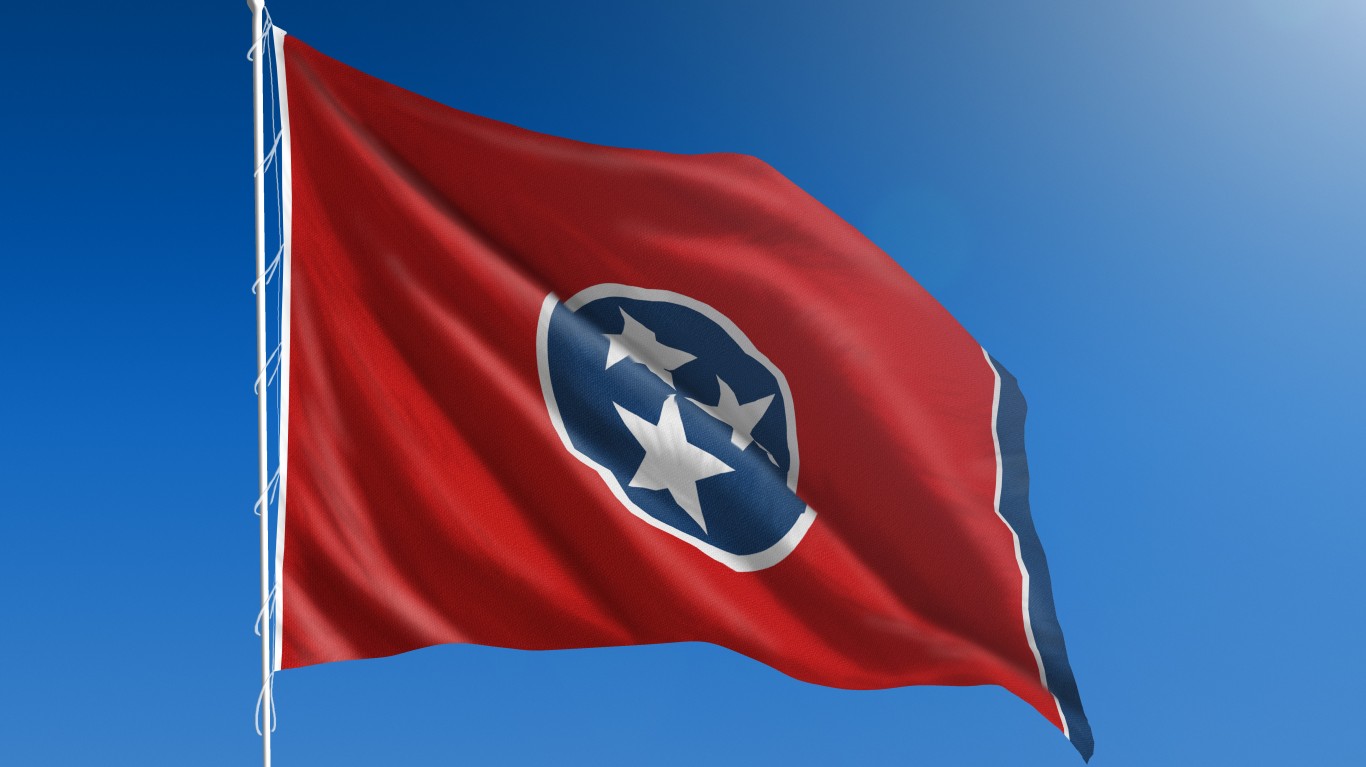
Tennessee
> Flag design: A blue circle with 3 white stars on a field of red, with a strip of white and blue on the fly
> Officially adopted on: 1905
The three stars on Tennessee’s flag represent the state’s Grand Divisions of the state: East, Middle, and West Tennessee. They are bound together by the endless circle, forming a trinity that cannot be broken — a symbol of eternal unity.
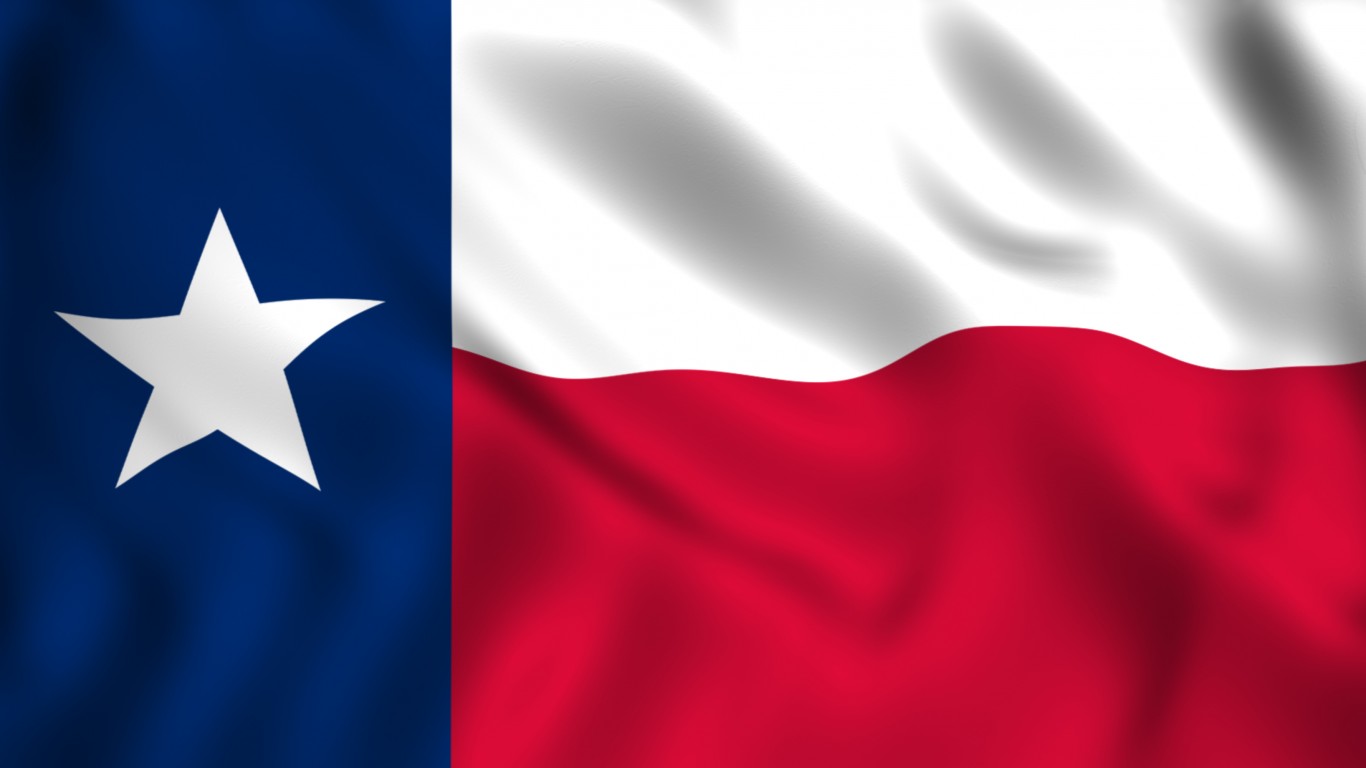
Texas
> Flag design: A third is blue with a white star in the center. The rest of the field is split in half by a white and red bar
> Officially adopted on: 1839
The Texas flag first flew over the Republic of Texas when it was an independent nation in 1839, and has not changed since. It gave rise to Texas’ nickname as “The Lone Star State.” The red, white, and blue of the state flag represent bravery, purity, and loyalty, the same as the color on the national flag.
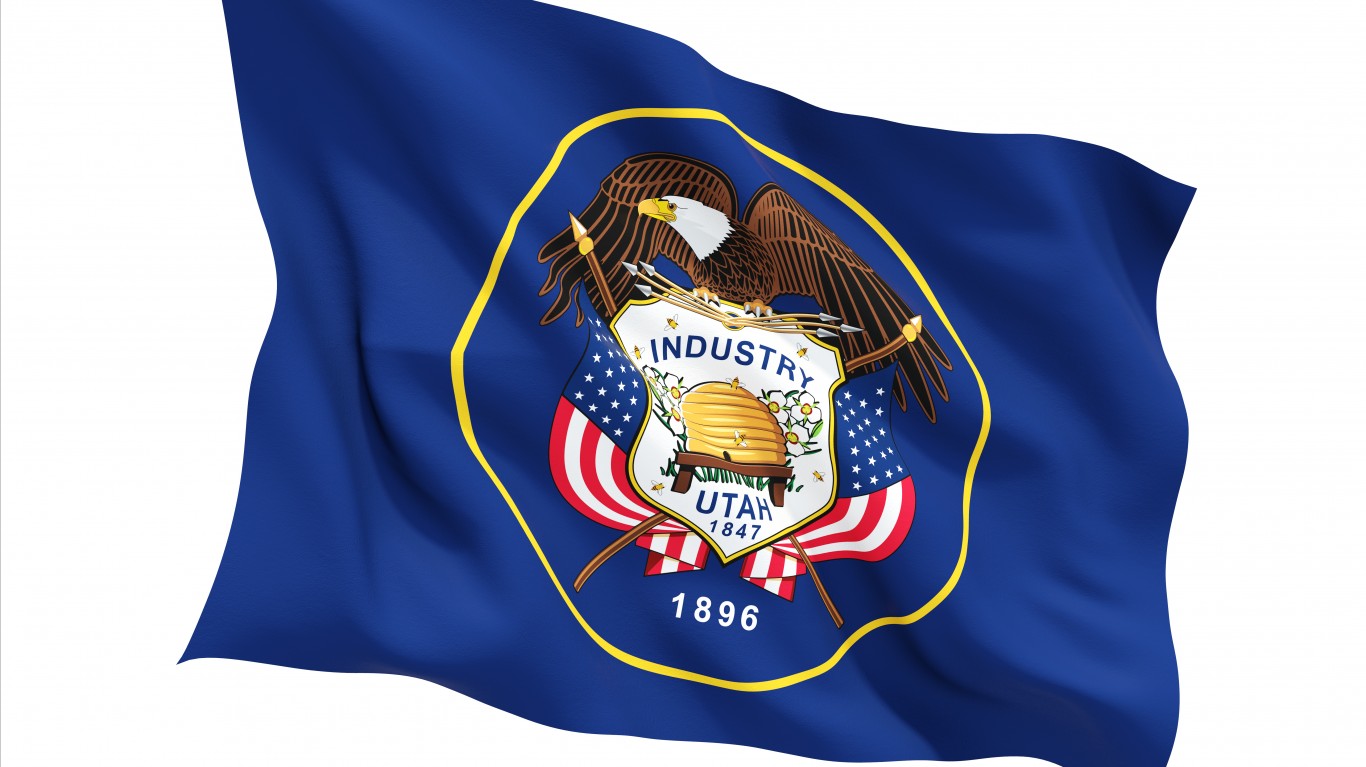
Utah
> Flag design: State coat of arms in a golden circle on a field of dark navy blue with the number ‘1896’ written in white
> Officially adopted on: 1911
The year 1847 included in the design of the state flag is the year the Mormons came to Utah. 1896, also on the flag, is the year Utah became the 45th state. The bald eagle, the national bird, symbolizes protection and loyalty to the country. The state motto is “Industry.”
[in-text-ad-2]
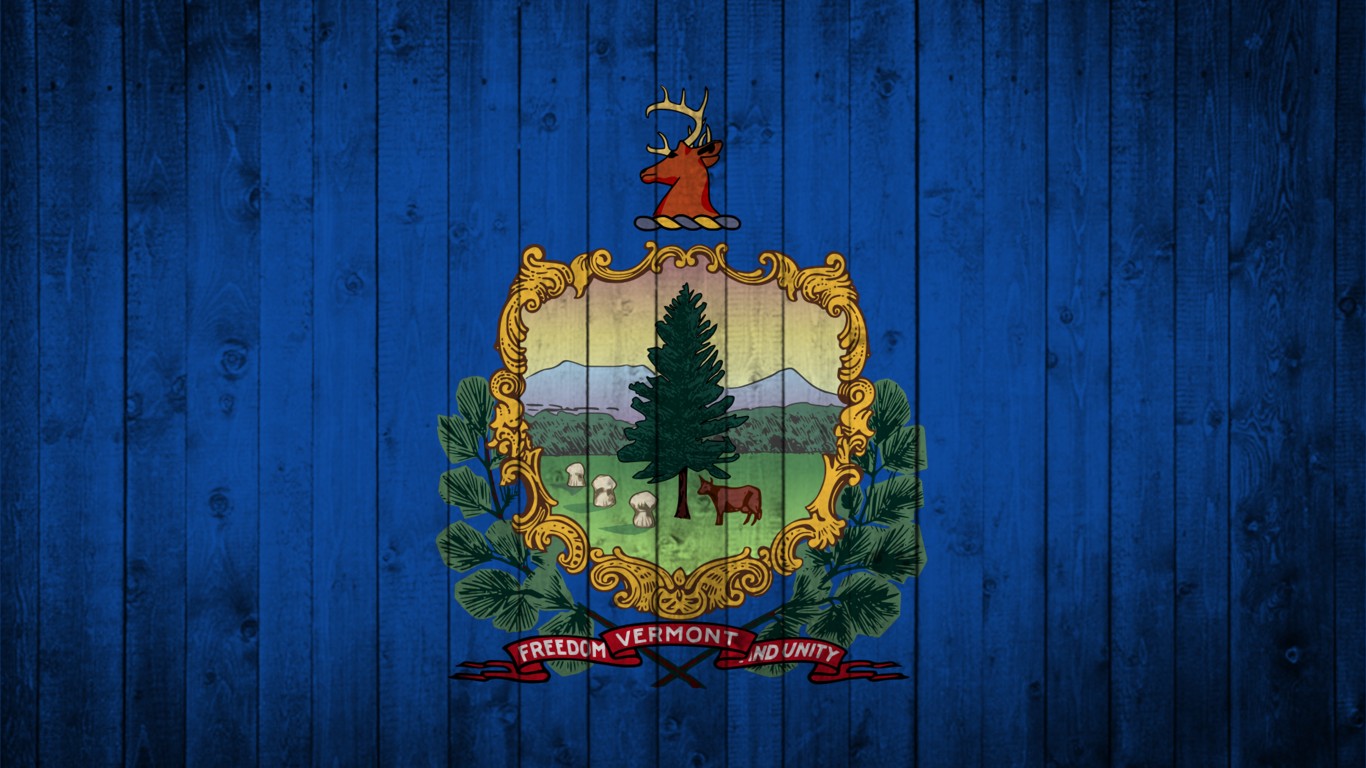
Vermont
> Flag design: State coat of arms on field of azure
> Officially adopted on: 1923
The cow, wheat, and pine tree in the coat of arms design on Vermont’s flag represent the agriculture of the state. The two branches of pine on the sides are a symbol of the sprigs of pine that the soldiers of Vermont wore during the battle of Plattsburgh during the War of 1812. The Green Mountains in the back are the state’s most famous geographic feature. The deer head at the top of the shield signifies the state’s wildlife.
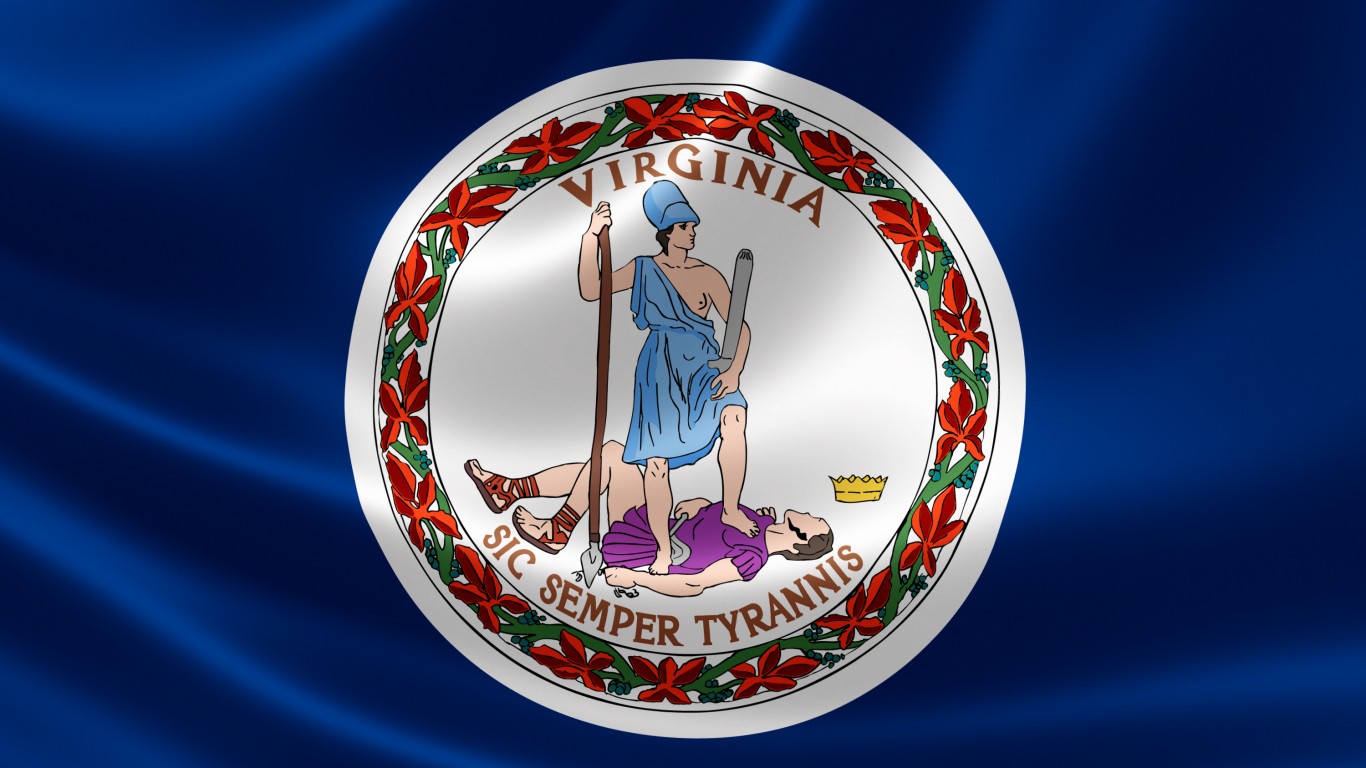
Virginia
> Flag design: State seal on an azure field
> Officially adopted on: 1912
The official state seal is represented on the Virginia flag. The seal features the goddess Virtus, who represents Virginia. She is depicted dressed as an Amazon, wearing a helmet and holding a spear and sword, above the Latin motto “Sic semper tyrannis,” which means “Thus always to tyrants.” She is standing over a defeated tyrant.
[in-text-ad]
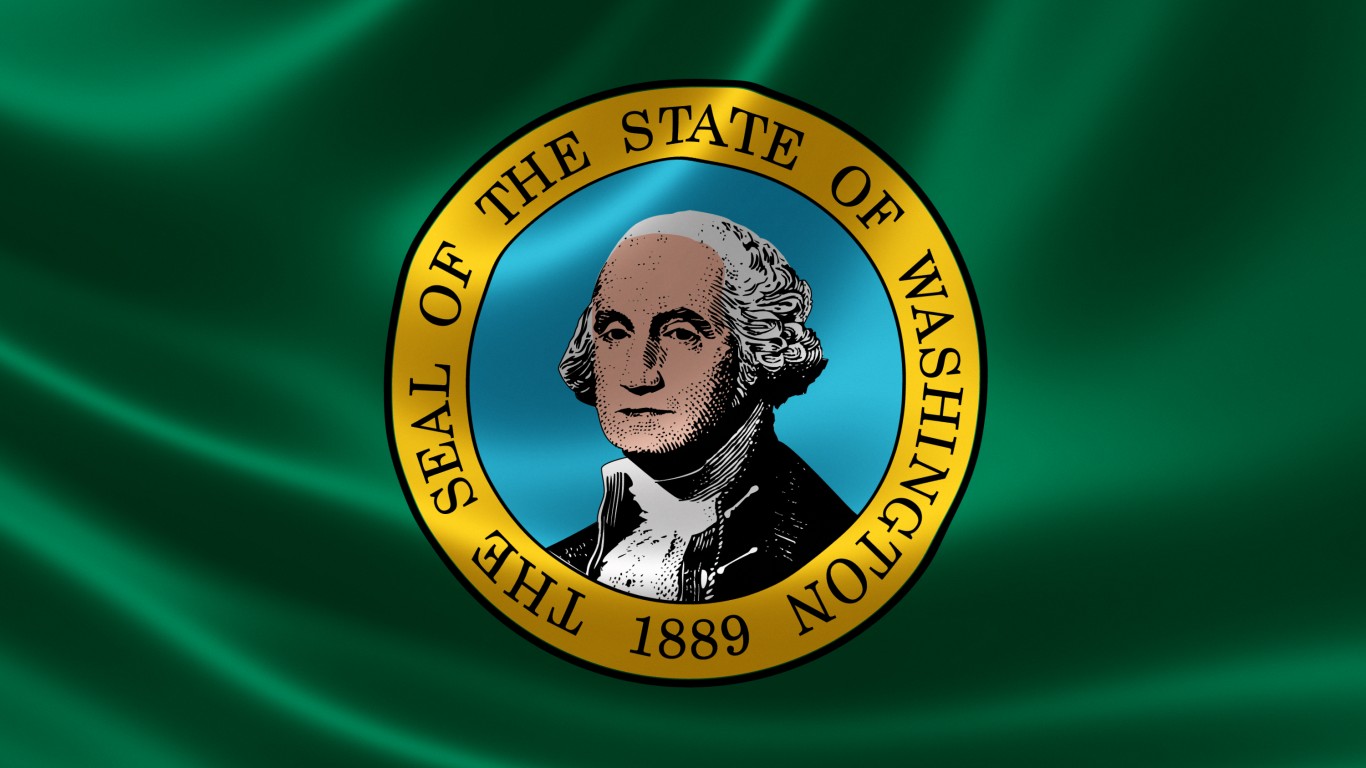
Washington
> Flag design: The state seal, displaying an image of state namesake George Washington, on a field of dark green (gold fringe is optional)
> Officially adopted on: 1923
Washington’s flag is the only state flag displaying an image of an actual person, George Washington. (Washington is the only state named in honor of a U.S. president.) It is the only state with a flag that features a green background.
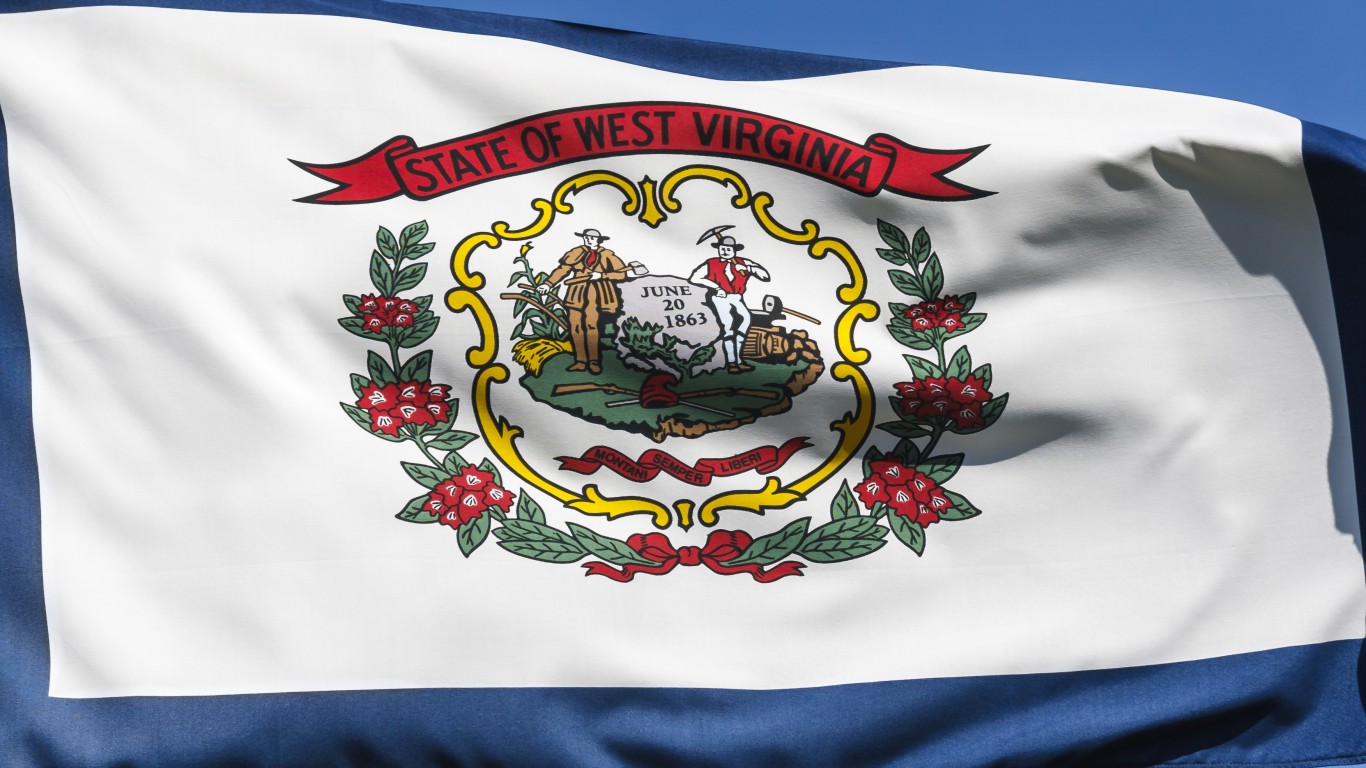
West Virginia
> Flag design: State coat of arms on a white field, wreathed by rhododendron with a red ribbon reading ‘State of West Virginia’
> Officially adopted on: 1929
The West Virginia flag has the state motto in Latin “Montani Semper Liberi,” which means “Mountaineers Are Always Free.” A wreath of rhododendron, the state flower, is also featured. The farmer and the miner in the design are standing next to a rock inscribed with the date when West Virginia became a state — June 20, 1863.
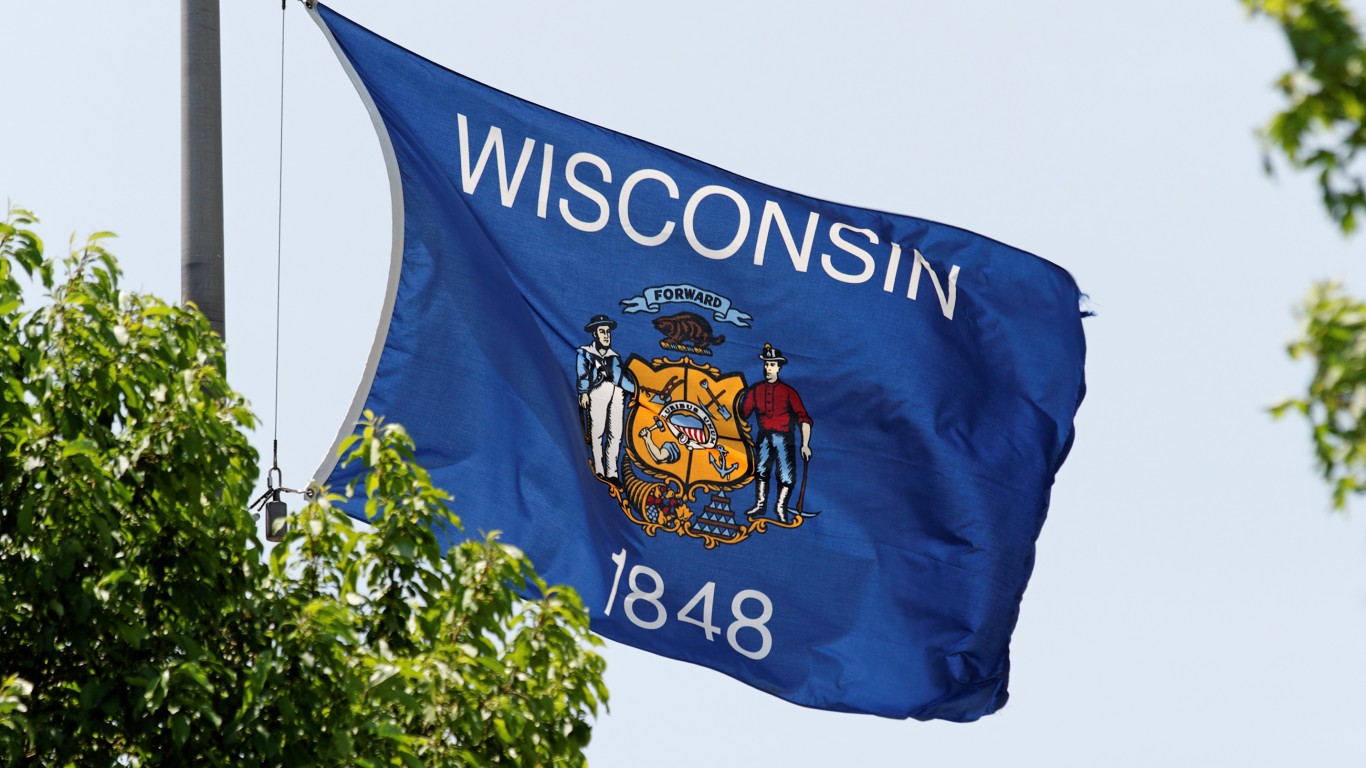
Wisconsin
> Flag design: State coat of arms on a blue field
> Officially adopted on: 1981
Wisconsin’s state flag’s design contains many symbols. The blue background represents wisdom and trust. The miner is a symbol of workers in the state; the sailor represents the state’s extensive coastline; and the golden seal signifies four major trades in Wisconsin — navigation, manufacturing, mining, and agriculture. “1848” refers to the year Wisconsin was admitted to the Union. The state’s motto, “Forward,” is included at the top.
[in-text-ad-2]
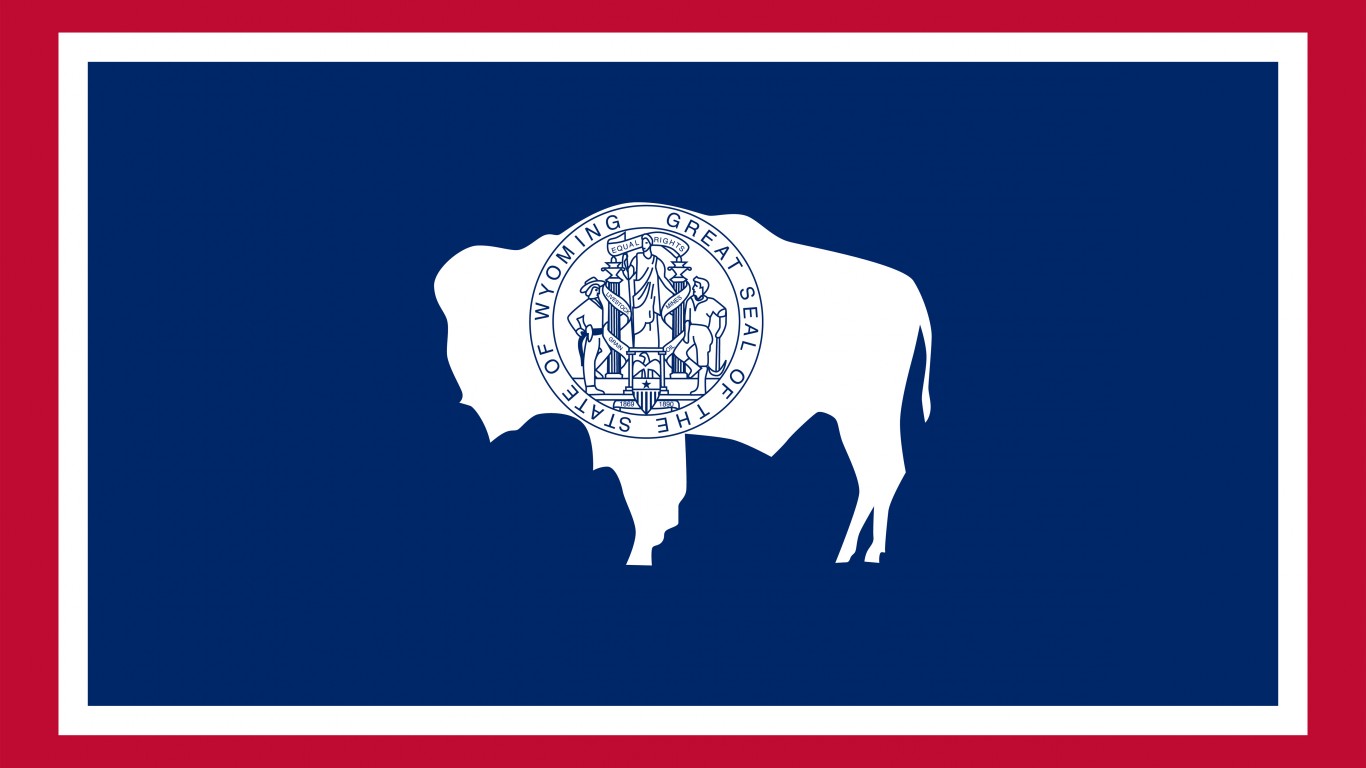
Wyoming
> Flag design: A silhouette of an American bison on a blue field, with white and red coats around it
> Officially adopted on: 1917
The bison is Wyoming’s official state animal. The red, white, and blue colors of the state flag are the same as the colors on the national flag. The red on the border is a symbol of the Native Americans who first lived in the region. The red also symbolizes the blood of the people who died for the land. White is a symbol for purity, and blue, the color of loyalty, stands for the state’s sky and mountains.
Thank you for reading! Have some feedback for us?
Contact the 24/7 Wall St. editorial team.
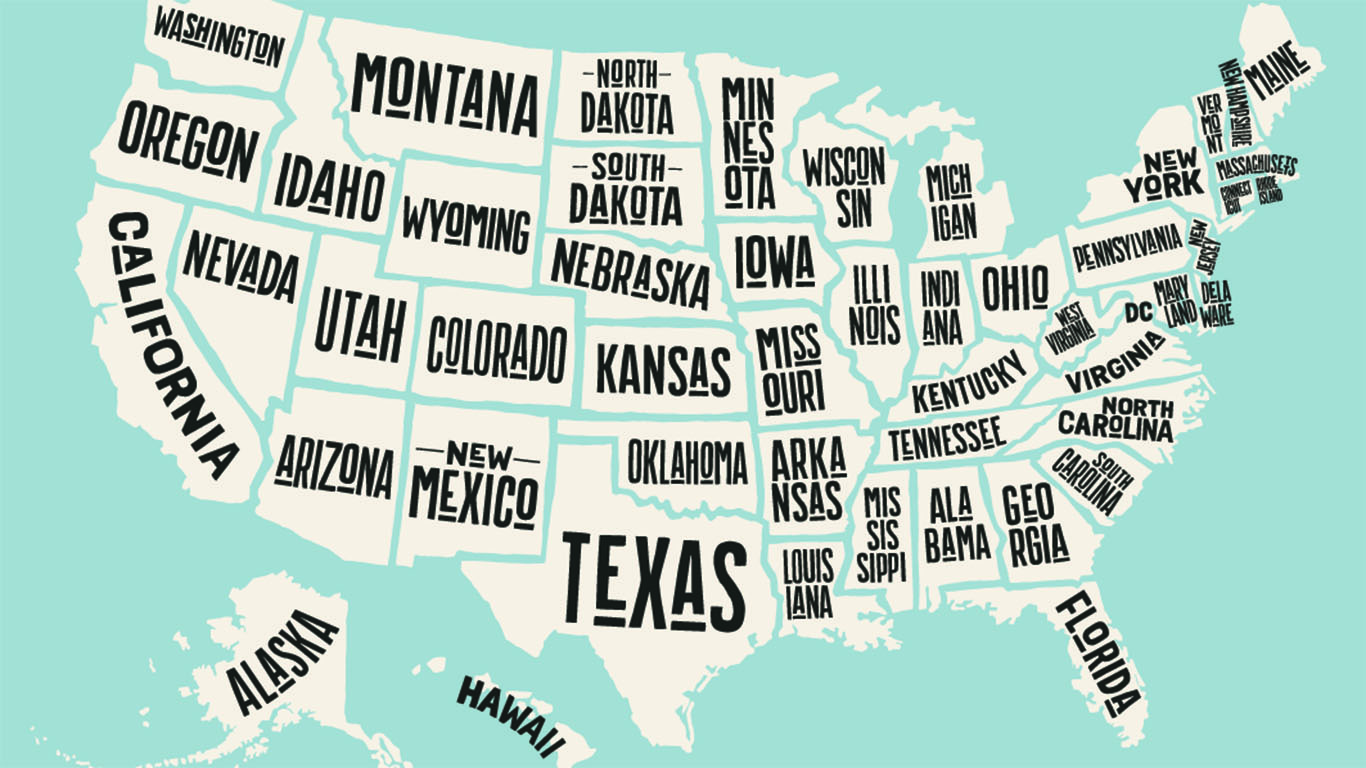 24/7 Wall St.
24/7 Wall St. 24/7 Wall St.
24/7 Wall St. 24/7 Wall St.
24/7 Wall St.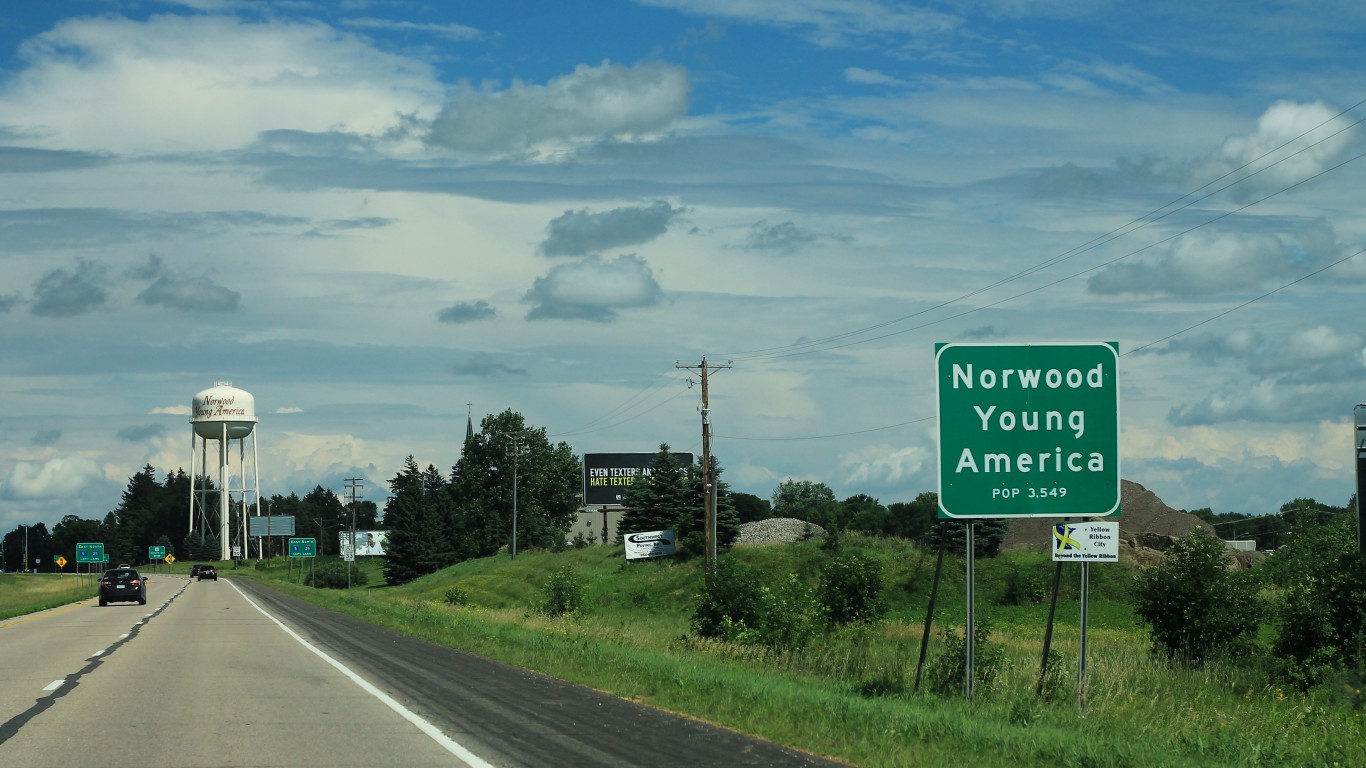 24/7 Wall St.
24/7 Wall St.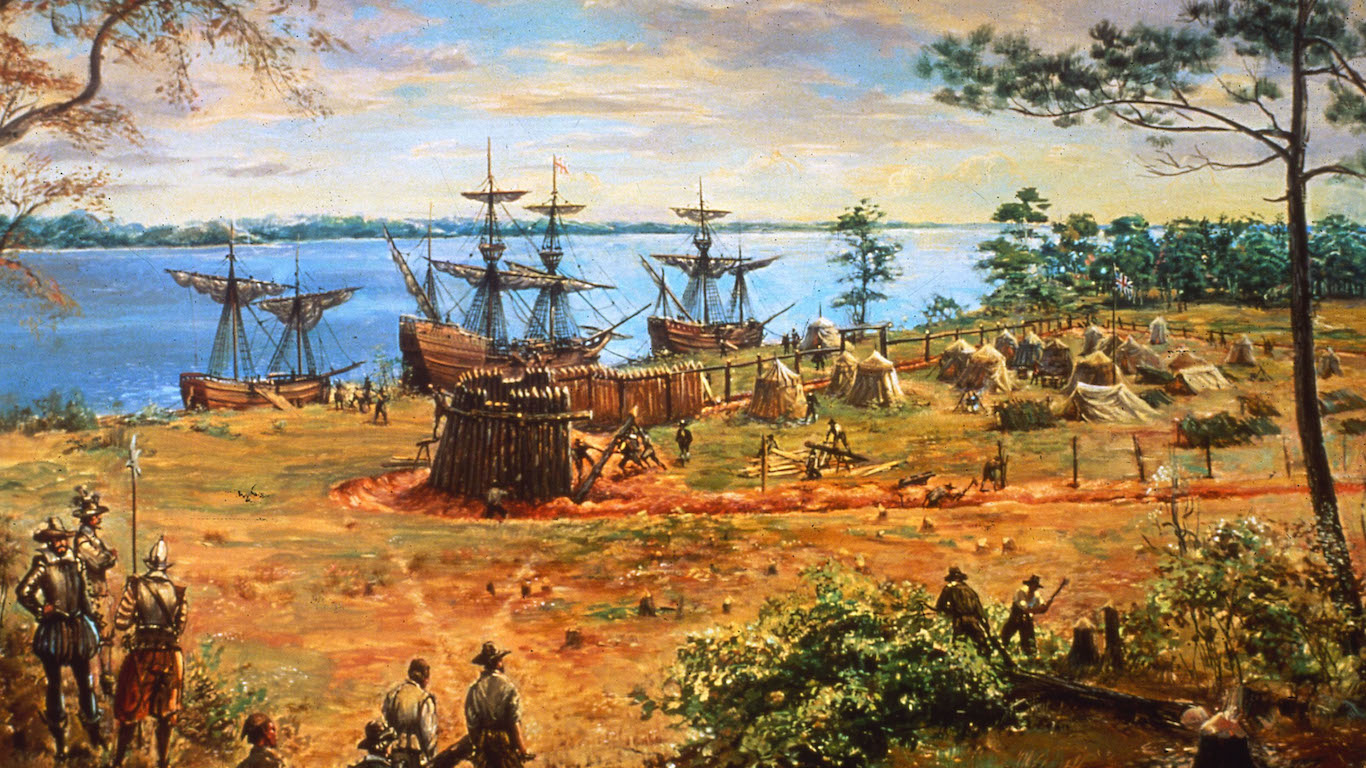 24/7 Wall St.
24/7 Wall St.